Abstract
The present research investigates the impact of networks and connectedness on the CEO compensation, CEO appointments, CEO labour market outcomes, and CEO termination. In addition, this research establishes the connections between the CEO and the hiring board and compares it to the general connectedness of the CEO. The study demonstrates that both forms of connectedness enhance conventional turnover and compensation variables in discrete and economically substantial ways. Precise connectedness enhances CEO appointment. What is more, the current research reveals that a CEO’s overall contacts, particularly with respect to employment network, boost the likelihood of CEO departure and re-employment prospects. Also a better turnover-performance sensitivity can be achieved.
The presence of precise connections between CEO candidate and the board of directors improves the prospects of appointment in case a firm opts to appoint an outsider as the CEO. Finally, the present study shows that CEOs with improved general connectedness benefit from better compensation. Finally, the results of the current research show that the CEO’s overall contacts, especially with regard to employment network, have considerable economic benefits in comparison to the current CEO-board connections.
Introduction
Overview
This chapter covers the background to the study, problem statement, research objectives and hypotheses and the significance of the study.
Background to the study
Various schools of thoughts including politicians, social media and scholars have given much focus on the excessively liberal compensation levels of executive directors (Bebchuk & Fried 2004; Adams & Ferreira 2007, p.220). There is a part of the research that dwells on the link between the social networks of the executive directors or the chief executive officers and their levels of compensation (Larcker et al., 2005; Barnea & Guedj 2007; Brown et al., 2008; Hwang & Kim 2009). This part of scholarly research generally looks into the significance of the connection of the executive directors to the corporate governance of the organization by paying great attention to the expected costs of the ties and pointing out the definite connection between various executives who are viewed to have the potential of creating agency problems to the organization (David 1965; Dean & Snell 1993; Barcelo 2000; Carter 2009).
It is very imperative to note whether the connection between the executive directors of the firm and the outside directors of the same firm produce any benefit or are expensive to the firm. In fact, these connections do have real benefits as they enhance the development of social networks which further enables the firm to have access to a wider spectrum of information at minimum costs. With regard to this, the worth, significance and relevance of the social networks is improved (Adler & Kwon 2002, p.22; Allen 1974; Westphal 1999, p.12; Wade, O’Reilly & Chandratat 1990, p.600). Social networks promote the interaction of the executive directors with each other, thus, enabling them to acquire and adopt the most modern business conducts that are practicable in the modern world.
The study has mainly centred on formal ties even though the theory of social capital indicates that the observable ties or connections and social connections supplement each another (Hwang & Kim 2009, p.102; Kay & Van Putten 2007; Mizruchi 1996, p.280; Mizruchi & Steams 1988, p.200; Kennishi 1994). The social connections especially the connections that are cantered on becoming club members or members of charitable organizations are perceived as platforms where amateur board members are acclimatised to the ethical standards and the moral values of the board (Palmer 1983, p.45; Pfeffer 1972; Pfeffer & Salancik 1978). Connections and networks which are cantered on joining together members of the board produce the same results as informal social networks. The act of joining together the board members mirrors in the corporate world and the existing social connection.
Technological innovations have made networking an integral part of business operations. Currently, social networking sites (i.e. ‘Twitter’, ‘LinkedIn’ and ‘Facebook’) have attracted millions of users around the globe. It is against this backdrop that the influence of networks on economic outcomes has drawn significant and increasing interest from researchers (Granovetter 1973, p.1366; Granovetter 1974; Kinicki 2009; De Wit & Meyer 2004). In many cases, the hiring board employs networks when it plans to provide an important decision-making process about the CEO (i.e. appointing, retaining, or firing a CEO). The CEO-board connections are likely to hinder the hiring board from efficiently observing and objectively chastising the CEO.
Board of directors who are socially connected with the CEO may approve higher compensation for the CEO without validation or may retain a non-performing CEO (Hwang & Kim 2009; Gui 2000, p.142). What is more, the structure and strength of the CEO’s general connectedness signifies his/her social capital as well as outside employment prospects (Burt 1992; Burt 2000). The prospect of a CEO (with better connections) to find a new job after departure from the current firm is quite high. Consequently, general connectedness can influence CEO compensation and turnover in various ways compared to the pair-wise precise CEO-board connectedness (Burt 2001; Burt 2005). Although previous empirical researches on CEO and director networks have not investigated the overall connectedness, the current study reveals that both forms of connectedness are crucial in numerous key roles of the board: CEO appointment, CEO compensation, and CEO firing (Core, Guay & Larcker 2008, p. 22).
This study employs biographical data of executives and directors in approximately 5000 U.S. firms between 1990 and 2007 (Smith & Watts, 1992). This study creates yearly networks ensuing from overlapping employment affiliations. In addition, the present study assesses the general connectedness of an individual by using four diverse measures from the existing relevant literature. For every pair of CEO and board of directors, the researcher tallies the precise links between them. In addition, the current research explores the effect of the two types of connectedness variables with respect to the decision to compensate CEO, hire CEO as well as CEO turnover.
To begin with, the present research explores how the network contacts of the current CEO can influence the prospect of a turnover event. The study establishes that the presence of links between the CEO and the board reduces the prospect of CEO turnover. Also it influences on the turnover-performance sensitivity. This finding implies that a CEO connected to the board can maintain his/her position irrespective of his/her performance. On the other hand, there exists a positive correlation between the CEO’s general connectedness and greater turnover-performance sensitivity. This finding reveals that the decision to leave by the current CEO is made easier by the existence more outside employment prospect.
Secondly, the correlation between the nature of employment assumed by the departed executive and his overall connectedness is explored in the current research. This study establishes that enhanced connectedness on the general employment network improves the prospect of a CEO assuming a senior position in another firm. Nonetheless, the pair-wise connection to the previous company’s board of directors has negligible impacts on the prospects of the CEO securing a better outside position. The finding of the current study demonstrates the distinctive influence of overall connectedness on CEO’s outside prospects, which is disregarded in previous studies (Hwang & Kim 2009).
The third subject addressed in this study is CEO appointments. By holding other discernable attributes of CEO candidates constant, the present study examines whether the prospects of being chosen as the new CEO is subject to the connectedness of the candidate. For the sub-sample of firms that opt to hire the new CEO from outside, this study reveals a positive correlation between the pair-wise connectedness (between the CEO nominee and board of directors) and the prospects of appointment. This outcome is in harmony with survey outcomes revealing that firms looking for a new (outside) CEO mainly depend on references from board members. For the sub-sample of firms that opt to elevate an insider to the CEO position, the present study reveals that general connectedness of the nominee has a negative effect on the prospect of appointment. It appears that the costs of hiring a highly networked CEO overshadow the benefits a firm gets from using the CEO’s contacts
Finally, the current study evaluates the relationship between CEO’s social contacts and his/her compensation. This study distinguishes between the precise CEO-board connectedness and the overall connectedness of the CEO. The findings of the present study demonstrate that the general connectedness has a larger influence on CEO compensation compared to the pair-wise connectedness. Excluding the CEO’s overall connectedness when taking into account the precise CEO-board connectedness can erroneously attribute the better compensation received by the well-connected CEOs to director prejudice only.
The current study makes a number of contributions. First, it illuminates on the network between CEO and the hiring board and compares it to the candidate’s overall connectedness to executive network This contradiction enables this study to unravel prospective entrenchment effects accruing from pair-wise connectedness from the impact of outside chances produced by general connectedness. Only one form of connectedness has been examined with the help of prior studies on corporate governance and social networks. For instance, a study by Kramarz and Thesmar (2006) focuses on the mutual similarity between the CEO and the board but overlooks the CEO’s general connectedness. They postulate that CEO-board connectedness decreases the monetary and disciplinary efficiency of the board, a phenomenon that is harmful to the company. In addition, Ang et al. (2009) examines only the social network of the CEO outside the firm. The findings of this study demonstrates that it is crucial to consider both forms of connectedness since each has considerable and discrete economic impacts on various key corporate resolutions on CEOs.
In addition, the empirical tests of this study offers proof on the significance of connectedness in all key choice variables relating to the CEO. As a result, the current research makes noteworthy contribution in the management sphere (i.e. CEO, hiring, CEO appointment, and CEO turnover literature). For CEO compensation, the findings of this study reveal that overall CEO connectedness improves his/her compensation (holding constant other ordinary variables). Consequently, the better compensation offered to well-connected CEOs could be attributed to the high demand for this human capital. This finding is also consistent with previous studies proposing that well-connected CEOs are offered better compensation as a result of poor governance (Hwang & Kim 2009).
The present study has also presented new findings regarding CEO appointments. Previous studies have explored the characteristic of the firm that influence the decision of a firm to hire a new CEO from within and outside the company (Powell & Smith-Doerr 1977, p.374; Rosen 1992, p.200; Stokman, Ziegler & Scott 1985). The present study investigates attributes of a CEO candidate that influence his/her prospects of being hired. To be precise, this study demonstrates that CEO-board pair-wise connectedness is crucial, particularly for firms that employ an outsider. With regard to CEO turnover, this research sheds light on certain findings reported in previous studies. For instance, Useem (1984) argue that well-connected CEOs display poor turnover performance since their likelihood of getting fired is low.
Furthermore, the network measures employed in this study are more inclusive compared to those used in previous researches on CEO connectedness. The present study defines various forms of connectedness. A distinction is made between overall (general) connectedness and pair-wise connectedness. Furthermore, the current research employs four measures (from graph theory) to expound more on the meaning of overall connectedness. The four measures take into account direct connections, indirect connections, the quality of connections, as well as the tactical position on the basis of the connections pattern (Uzzi 1997, p.43; Yermack 1996, p.200).
As a final point, a considerable cluster of executives (derived from over 5000 U.S. companies) were used as the sample population in the current study. The range of network formation entails connections created in public and private firms, learning institutions, as well as foreign countries. Previous studies on social networks have stereotypically explored a smaller sample of firms (Hwang & Kim 2009; Zahra & Pearce 1989). In addition, given that the unit of analysis in the current study is a single executive (CEO), the magnitude of social networks is bigger compared to those explored in previous studies (Fracassi 2008; Fernández, Castilla & Moore 2000; Hambrick & Finkelstein 1995).
Problem statement
Under the Social Network Analysis (SNA), there are certain measures and techniques that have been formulated to gauge the connection of the executive directors of the firm and the outside directors. It is to be noted that when an executive director or an outside director is well connected, the level of compensation also rises. With regard to this, two inferences can be drawn; the first inference is that both the executive directors and the outside directors are compensated because they have made available precious resources to the firm through their connections (Cressy 1996; Davis & Greve 1997, p.25; Batagelj & Mrvar 2009; Creech 1995). The second inference that can be drawn is that both the executive directors and the outside directors use their managerial influence through their connections to gain their compensations, thus, resulting to them getting paid without proper performance (Bebchuk & Fried 2004; Barr 2000, p. 542; Bryman & Bell 2003; Deci & Ryan 1985).
In order to point out the main distinguishing factor between the above two inferences, this study seeks to explore on the link that exists between the level of connection of the firm in general established by the combined connections of the board members, and the expected performance of the firm in the near future. In this case it is found out that the general level of connection between the executive directors of the firm and the outside directors is directly correlated to the expected performance of the firm in future. These views point out that the firm’s executives and the outside directors are compensated for the level of connection and resources that they fetch to the firm, and also for the exceptional performance that these resources bring to the firm. All these views hold when various control variables are incorporated to stand-in for the human capital of the firm’s executives and the directors from outside the firm. This notion is very relevant because the theory of social capital and human capital are distinct from each other (Field 2003, Gabaix & Landier 2008, p.67; David 1958; Hallock 1997, p.333; Cofer & Appley 1967).
Objectives of the study
Paying great attention to this notion, it is relevant to investigate if there are any beneficial informational supplies that can be gained from the link between executive directors of the firm and directors from outside the firm. This connection between the directors can also grant the firms’ executives with a certain level of managerial influence which they can use for their own individual gain (Baker & Iyer 1992, p.316; Conyon & Peck 1998, p.151; Kinni 1994; David 1965; Coopers 2005). The main distinctive factor of this paper with regard to other related studies is that this paper looks into the expected gain of the general association of the executive directors at both individual level and at firm level. The specific objectives of this study include:
- To investigate whether the connectedness of the executive directors and outside directors determine their level of remunerations;
- To examine whether the overall association between the executive directors and the outside directors generates efficient resources to the firm.
Burt (2005) in his study employed a social capital theory in order to investigate the relevance of the connections between executive directors and outside directors with regard to their remuneration level and the general performance of the firm. This theory (social capital theory) has enabled the development of speculative systems or measures that elaborate on whether an executive director can benefit by accessing relevant information, bringing together practical actions, and monitoring those actions as a result of their degree of connectedness.
Literature Review
A number of researches have been carried out in the recent past to explore the correlation between social contacts and CEO compensation. In a study conducted by Hwang and Kim (2009) that is more connected to this, the results revealed that organisations in which the board members are socially connected to the CEOs always reward their CEOs with a bigger amount of compensation. In addition, their results pointed out that those organisations whose board members are more socially tied to the CEOs usually demonstrate a fragile pay-performance ratio and a lower probability of the CEOs coming and going out of the firm, as compared to those firms that have board members who are sovereign in social terms. As opposed to other related papers, this paper addresses divergent issues, employs divergent measures of social connection and improves on the population sample.
The study conducted by Hwang and Kim (2009) mainly centred on a new version of measuring the independence of the board members of the firm that investigates how the social connection or network upsets the reliability of the supervision of the board. This paper on the other hand, tackles the issue from the point of view of the CEO and investigates on how the various types of social networks affect the productivity and the reliability of the CEOs. In the past various authors have pointed out that social ties are described with regard to mutual conditions, for instance, common regional descent, or scholarly disciplines. These mutual conditions imply that there are common characteristics that the CEOs and the board directors have in common which prove that indeed there is a social connection between them. Social networking makes it possible for the CEOs and the directors of the company to gain access to information which is very relevant for the forward movement of the firm (Johnson, Daily & Ellstrand 1996, p.412; Lambert, Larcker & Weigelt 1993, p.442; Lorsch, & Maclver 1989). There is a thick line between general social connection and specific social connection. This study seeks to explore on specific social connection directly. Furthermore, the study reveals new approaches concerning outgoing CEO’s previous position and the incoming CEO’s employment.
Other scholarly articles in the area of social networks include the studies conducted by Kramarz and Thesmar (2006), Yang (2009), and Barnea and Guedj (2006). The study conducted by Kramarz and Thesmar was to examine social networks in a firm’s board room, employing a case study of firms in France. The two researchers demonstrated that CEOs with strong connections to the hiring board are less likely to be fired regardless of their work-performance. Just a few scholarly studies contemplate the social network between the executives of the company and the directors from outside the company. The study conducted by Barnea and Guedj revealed that firms or companies which have board members with a stable social network to the outside directors often compensate their executive officers handsomely. In addition, Barnea and Guedj point out that when the directors of a firm are exposed to the normal customs of another firm, their level of compensating their executives is bound to change to be in line with the level of compensation that exist in the other firm.
Ang et al. (2009) also investigated the implications of social networks on the compensation of the firm’s executives. The study was conducted with regard to the point of view of the CEOs, where it found out that CEOs who had a stable social network or connection were awarded better social benefits. These CEOs have a tendency of demanding a higher amount of remuneration in order to maintain their social status. The same study conducted by Ang et al. (2009) centred only on one type of social network. This study, however, contemplates both the social networks that exist between the CEO and the board, and also the general connection or social network that the CEO enjoys. The most common result that has been revealed by these related scholarly articles point out that social networks often endanger the management of the firm by interfering with the inducements that accrue to the firm, or the capabilities of the board members to efficiently supervise the CEOs to make sure that they do not become egocentric. Executives who have an efficient social connection often are awarded a higher level of compensation and cannot just be fired easily. The findings of this paper reveal the fact that social connection has some other consequences apart from being a sign of inefficient governance. One illustration can be the fact that it leads to the creation of job opportunities from outside of the firm.
One element of this study builds up to the previous studies conducted to investigate the factors that determine the returns of the firm’s executives. A study conducted by Stuart and Yim (2008) found out that the stock performance of the firm is negatively correlated to the changes in the firm’s top management. These changes include: replacement of the firm’s CEO, replacement of the firm’s president, replacement of the board chairman and replacement of the board members. In a previous study conducted by Krackhardt (1990) (which is also related to link between the stock performance of the firm and the changes in the top management of the firm), a firm’s stock performance is inversely correlated to the likely changes of the CEOs of the firm. Furthermore, the connection between the performance of the firm and the changes in the top management is very well-built in firms that have board member largely coming from the outside (Boxman, De Grant & Flap 1991, p.55; Burt 1987, p.1293).
A study by Parrino (1997) revealed that the prospect of CEO turnover is higher in industries characterized by homogenous companies than in heterogeneous industries. Using a similar argument, but from a different perspective, this study demonstrates that the presence of attractive outside positions for CEOs seem to be a key aspect in terms of CEO turnover events. A study by Huson et al. (2001) sought to explore CEO turnover events between 1971 and 1994. According to his findings, the turnover-performance link did not alter considerably during the study period, although there were remarkable adjustments in internal governance mechanisms.
What is more, Huson et al. (2001) and Parrino (1997) explored CEO succession decisions in their respective studies. In both cases, the researchers categorized succession outcomes with respect to whether the hiring board appointed an insider or outsider as the new CEO (Huson et al., 2001). According to Parrino (1997), the probability of firms in homogenous industry to appoint new CEOs from outside is high. In addition, Huson et al. (2001) shows a rise in the number of outside succession during the sample period. These findings seem to propose that the rising trend in outside appointment mirrors enhanced board thoroughness in monitoring the CEOs. Consequently, the current study uses previous works to explore, independently, the decisions made by the board to hire an insider and those for hiring an outsider.
In addition, the current study makes significant addition to the existing literature with respect to the significance of social contacts in finance and economics spheres. The current literature demonstrates a strong correlation exists between CEO-board connectedness and business operations. For example, Cohen et al. (2008) explores the links between corporate directors and mutual fund executives through mutual education networks. Stuart and Yim (2008) also explore the relationship between executive networks and the creation of private equity transactions aimed at U.S. firms. The two researchers report that the probability of a company acquiring a private equity is high if some of the executives in the firm possess knowledge regarding leverage buy-out through outside board service. In nutshell, the current study demonstrates that networks are also crucial in the CEO labour market.
This study also employs instruments cultivated in the science and sociology spheres. For instance, Newman (2003) offers an all-inclusive assessment of academic advancement in the sphere of complex networks. According to him, one of the key problems handled in social network research is detecting which people are most central, important, or best linked to others. Usually, researchers employ scientific graph theory to measure the concept of centrality. Some of the commonly used centrality measures are: eigenvector (Bonacich 1972); betweenness (Freeman 1977); closeness (Sabidussi 1966); and degree (Proctor & Loomis 1951). Thus, the present research employs the four measures to define and explain an individual’s overall connectedness in the executive network. These measures are described in the following section.
Research Methodology
Introduction
Methodology is the process of instructing the ways to do the research. It is, therefore, convenient for conducting the research and for analyzing the research questions (Easterby, Thorp & Lowe 2008; Saunders, Lewis & Thornhill 2009). The process of methodology insists that much care should be given to the kinds and nature of procedures to be adhered to in accomplishing a given set of procedures or an objective.
Research philosophy
For this part, choosing a philosophy of research design is the choice between the positivist and the social constructionist (Easterby, Thorp & Lowe 2008). The positivist view shows that social worlds exist externally, and its properties are supposed to be measured objectively, rather than being inferred subjectively through feelings, intuition, or reflection. The basic beliefs for positivist view are that the observer is independent, and science is free of value. The researchers should always concentrate on facts, look for causality and basic laws, reduce phenomenon to simplest elements, and form hypotheses and test them.
Preferred methods for positivism consist of making concepts operational and taking large samples. The view of the social constructionists is that reality is a one-sided phenomenon and can be constructed socially in order to gain a new significance to the people. The researchers should concentrate on meaning, look for understanding for what really happened and develop ideas with regard to the data. Preferred methods for the social constructionists include using different approaches to establish different views of phenomenon and small samples evaluated in depth or over time (Saunders, Lewis & Thornhill 2009). For the case of analyzing how social network analysis affect compensation level of executive directors during different economic periods, the philosophy of the social constructionists was used for carrying out the research. Because it tends to produce qualitative data, and the data are subjective since the gathering process would also be subjective due to the involvement of the researcher.
Research methodology
Human resource management has multifaceted subjects. Any researcher can centre on distinct areas, for instance, safety of the workers, remuneration procedures or hiring new staff members. This paper mainly focuses on the impacts of social networks because it entails evaluation of the staff, localization, tapping up and retaining new talents that are essential for the growth of the firm.
This research will manly use the qualitative methodological approach as it describes the precise behaviours of companies. Qualitative methodological approach enabled the researcher to point out clearly the values that drive the strategies of the research (Easterby, Thorp & Lowe 2008; Saunders, Lewis & Thornhill 2009). Qualitative methodological approach is preferred over quantitative methodological approach as the latter does not capture all the variables, thus, producing unreliable results. Quantitative analysis and quantitative analysis serve as the two central methodologies of a research.
Qualitative research is a way of research question captured in various academic fields of study, conventionally used in the social sciences, but also in research on market and other areas (Saunders, Lewis & Thornhill 2009). Exhaustive apprehensions of human demeanour with regard to qualitative researchers are being carried out with an aim to assess the causes that relate to such demeanour. The qualitative method investigates the question as to how and why decision making is carried out; hence, focused and smaller samples are more frequently preferred to huge samples. Quantitative methods on the other hand verified the validity and truthfulness of the hypotheses; qualitative methods can be explained as a source of data or an explanation based on the dimensions of the graph or a non-mathematical data collection (Easterby, Thorp & Lowe 2008; Saunders, Lewis & Thornhill 2009).
Nonetheless, the most customary demarcation between the uses of quantitative and qualitative research especially in the social sciences is that qualitative procedures are employed for illustrating confounding quantitative outcomes or for exploration (i.e., conjecture-engendering). On the contrary, quantitative methods are being employed to evaluate theories. This has been demonstrated as one of the fundamentals of qualitative research. Some critics think that quantitative method of analysis purposes to offer many illustrations, precise and reliable evaluation mainly through cantered conjectures, applied mathematics and evaluation tools (Saunders, Lewis & Thornhill 2009). On the other hand, qualitative data is normally tedious to display or graph in mathematical terms.
Qualitative research is mostly accepted as the best technique for evaluating policies and research programs. Qualitative research provides clarifications to the various issues arising in a unique way that is dissimilar to the quantitative approach. This is especially the case for comprehending why and how some results were accomplished (not just what was accomplished) and also for replying some significant queries about pertinence, unplanned effects and impact of processes such as: were anticipations justifiable; did procedures function as anticipated; were chief policy makers able to do their jobs; did the program create any unintended impacts; and so on.
Network Analysis Instruments
Connectedness or networks are rather complex concepts that permit various interpretations. In essence, they demand more precise definitions in order to measure them in an empirical research. The current study employs network analysis tools (as constructed in science and sociology spheres) to develop director and executive networks. Also it aims at enhance assessment of individual positions.
According to graph theory, a network refers to a cluster of connections and units (nodes or vertices) between them (see fig. 1). Different central measures have been constructed to define the relative importance of a vertex on a network. With regard to the current study, centrality measures have been used to define the degree of connectedness of an executive or director on the network of corporate leaders. Contrary to the internal connections that merely reveal how CEOs are connected to the board in a given firm, centrality measures depict the general connectedness of a person within the network comprising of the entire business executives and directors.
The major benefit of employing various measures, as opposed to a single one, enables a researcher to capture multiple facets of the concept connectedness as well as facilitating the comparison of their impacts. Wasserman and Faust (1997) posit that one measure “…is just one of many manifestations of the primary centrality concept. One should not utilize any single centrality measure. Each has its virtues and utility.” The current study used four centrality measures for analysis: eigenvector, betweenness, closeness, and degree. In summary, the eigenvector centrality refers to the weighted sum of direct connections possessed by a node; the betweenness centrality describes the key role of a node in terms of decreasing the gap between all pairs of other nodes; the closeness centrality refers to the inverse of the average distance between a node and all other nodes within the network; and the degree centrality refers to the sum of direct connections a node possesses (Bonacich 1972; Freeman 1977; Sabidussi 1966; Proctor & Loomis 1951). The following subsection presents a mathematical description of these four measures.
Description of Centrality Measures
Proctor and Loomis (1951) were the first researchers to develop degree centrality measure to demonstrate the dynamic nature of a node. The absolute degree cD(x) of a node x basically refers to the sum of edges that link x with other nodes. The closeness centrality measure shows the ability of an individual to swiftly interact with other people within the network. The closeness degree measure, suggested by Sabidussi (1966), differs from the degree centrality since it only focuses on the direct and indirect links amongst units. The equation for absolute closeness of a node (x) is presented below:

Where U= set of all nodes within the networks, and d(x, y) = sum of edges within a shortest path linking units x and y.
Freeman (1977) introduced the betweenness centrality measure to show the ability of an individual to behave as an arbitrator, bringing individuals together. An individual is central, if he/she lies on numerous direct paths amongst other pairs of individuals (Freeman, 1977). The flow of information within the network can be controlled by them. Thus, the absolute betweenness of a node (x) is expressed by the following equation:

Where m(y, z; x) = number of direct paths between y and z via unit x, and m(y, z) = the sum of direct paths between y and z.
The eigenvector centrality measure, as suggested by Bonacich (1972), lends credence on the quality of a connection. The elementary notion is that a connection to a central node is more significant in comparison to a node on the edge. Assume that n x n matrix (M) is the adjacency matrix of the network. To be precise, Mij=1 if there is a connection between nodes i and j, and Mij=0 if such a connection is nonexistent. Also, assume that n x 1 vector p fulfils the following conditions: (1) Mp= ap, where (a) is the biggest eigenvalue of M; and (2) maxi (pi) =1. At that point, the eigenvector centrality measure of node x, CE(x) relates to the xth element of p. Basically, eigenvector centrality becomes a recursive measure of degree, whereby the node’s centrality is described as the number of its connections to other nodes, weighted by their corresponding centrality measures.
Normalization
Absolute betweenness, centrality, closeness, and degree centrality are associated with the network’s size. Taking into account a central node within a small network, a value of absolute centrality measure would be lesser compared to a peripheral individual within a large network. Therefore, it is vital to normalize these four measures, in terms of the network’s size, in order to be able to compare the scope of connectedness across several networks. Consequently, for the purpose of this study, relative centrality measures are defined below:
The relative degree of a node (x) is described by the following equation:

Where cD(x) = the absolute degree centrality, whereas n= the sum of nodes within the network. The relative closeness is described by

Where cB(x) =the absolute degree centrality, whereas n= sum of nodes within the network. It is important to note that the theoretical maximum values of all relative measures are 1.
Components
It is rather challenging to define multiple network measures if the entire nodes within a network cannot be interconnected. Thus, a network component refers to a subset of nodes interconnected via paths running along links. The biggest component is the one comprising of the highest sum of nodes. For instance, figure 1 shows a network made up of three components. The first component comprises of v1and v2 nodes while the second one has three nodes (v3, v4, v5). All other nodes are subset of the main component.
Problem may surface when the direct distance (d) remains indeterminate for unrelated pairs. Usually, one allocates immeasurable d to the unrelated pairs. Nonetheless, the mean value of d also becomes immeasurable while the value of closeness measures (see equation 1) becomes zero for entire nodes. In addition, the value of betweeness measures (see equation 2) cannot be computed. To bypass this problem in the current study, the researcher computed the closeness and betweeness measures of the component associated with each individual. In addition, the researcher scaled the ratio of the extent of this component as well as the magnitude of the entire network (Sabidussi 1966).
An Illustration
Figure 2 presents a simple network, proposed by Krackhardt (1990), which consists of 10 nodes and 18 edges. It also reveals the distinction of various centrality measures. In addition, the values of normalized eigenvector centrality, betweeness centrality, closeness centrality and degree centrality are shown in table 1. According to figure 2, Diane has the largest degree measure. In addition, Diane has direct links with six individuals, and hence exhibits the largest normalized degree measure of 0.667. Nevertheless, when both direct and indirect connections are considered, Diane does not possess the largest closeness measure within the network. For instance, it takes her one step to reach each individual within the network. Heather can be reached within two steps while three steps will bring to Ian. Four steps are required to approach Jane. Thus, CC (Diane) = 0.067 and Cc (Diane) = (10-1) x 0.067= 0.600. On the other hand, Frank and Gary enjoy the largest closeness measures (0.643). Even though they exhibit lesser direct connections compared to Diane, the form of their direct and indirect connections enables them to swiftly reach other individuals within the network.
In addition, the degree measure is extended by the eigenvector centrality in another way. The eigenvector centrality refers to the weighted total of direct connections. For instance, according to fig. 2, Heather and Carol have identical sum of direct connections, cD (Heather) = cD (Carol) =3. Nonetheless, they are linked to different individuals. Heather’s contacts are Frank, Gary, and Ian. On the other hand, Carol’s contacts are Frank, Diane, and Andy. When their contacts are compared, we observe that the degree measure for Diane is larger (6) compared to Gary’s (5) while the degree measure for Andy is larger (4) than that of Ian (2). Consequently, the quality of Carol’s connections is greater compared to Heather’s. This is demonstrated by the calculated values of eigenvector centrality: CE (Heather) =0.407 and CE (Carol) = 0.594.
The computation of betweenness centrality entails locating the direct paths between all other pairs within the network. Assuming that Andy (see fig.2) is omitted, there are (n-1) (n-2) /2=36 pairs of nodes within the network, and Andy lies on one of the two direct paths between Carol and Brad. In nutshell, m (Brad, Carol; Andy) =1 and m (Brad, Carol) =2. In addition, Andy lies on one of the three direct paths between Frank and Brad. Consequently, cB (Andy) = (1/2) + (1/3) = 0.833 and CB (Andy) = CB (Andy)/36=0.023. Thus, it becomes apparent that Heather has the largest betweenness measure within the network. She acts as an arbitrator by interlinking two parts of the network. Although Heather’s contacts are fewer, they are nonetheless essential since she can use them to control information flow within the network. What’s more, betweenness centrality is perceived as a measure of network flexibility. It reveals the number of direct paths that will lengthen when a vertex is taken out from the network. Using the illustration above, Jane and Ian will be detached from the entire network if Heather is taken out.
In conclusion, each of the four centrality measure depicts a distinctive and essential aspect of connectedness. For example, the betweenness centrality lends credence on the links to diverse parts of the network a node with a greater betweenness measure has the ability to access more affluent and discriminated information. The eigenvector centrality employs recursively described weights to assess the quality of connections, although it is somewhat complex to understand. The closeness centrality takes into account all potential connections within the network and gauges the number of steps an individual must take in order to reach all of them. Finally, the degree centrality deals with how busy an individual is in networking. Nonetheless, it does not take into consideration indirect connections since it deals with each link equally.
Data, Results and Discussion
Data
This section looks at the data sources and the utilization of the variables in the regression models.
Sources of data
The connection between the firm’s executives and the outside directors was built up using data from BoardEx, which is an established research company that mainly focuses on providing social network statistics concerning corporate leaders. BoardEx Company centralizes the data regarding the directors of the board and the top executives of public companies which are quoted on the securities market and private companies which originate from a public set up. When collecting the data, the educational history of the employee is considered in addition to his/her employment background and whether he/her is a member of any club. Indeed, the biographical history of the employees that is provided by BoardEx Company has been collected over a long period of time.
Variables used in the regression
Social network measures
The link or association between an executive and the directors of the firm have been expressed in this study as dummy variables. Any individual from outside the firm or who is not an employee of the firm is categorized as someone who is connected to the firm’s board, especially if the individual had previously been employed in another company as a director or an executive in the same period as the current board members of the firm. Any individual who is currently an employee of the firm is categorised as someone who is connected to the board, especially if the individual had previously been employed on and off the firm.
Apart from the measures that assess the pair-wise link (connection) between outsiders and the directors of the firm, the overall measure of connection is defined in order to evaluate the general network. In addition, the measures of centrality are determined by building up a yearly network using a sample of between 1990 and 2007. With each given year t, yearly networks encompass anybody who is considered to be a board member or a proved beneficiary of a company in the US between year t – 5 and year t. For instance, if any two individuals were directors in the same company or were proved to be beneficiaries of the same company in the same time period, i.e. 6 years, then a connection is created between the two individuals. This system of establishing a connection has the merit of maintaining the relevant information that originate from the past and also lessening the level of correlation that exists between the measure of the individual’s network and the time period in which the individual has been listed in the data sheet. However, the findings of this paper are not responsive to the selected 6 years.
Table 1 illustrates the general constitution of the 18 yearly networks. In this table, the list of all the individuals who are perceived to be in the network is provided. In addition, the table illustrates the magnitude of the biggest constituents and the number of constituents whose sizes are at least 30. Nevertheless, the table also illustrates the number of the executives of the companies considered to be public. The major observation that can be drawn from the table is that the level of networks rose from year to year, i.e. in 1990, the level of network was 20,151 and in the final year, 2007, the level of network was 59, 751. With regard to this observation, this study employed a relative measure of centrality with the aim of enhancing a better relationship over time. Another major inference that can be deduced from the table is that the biggest constituent has an absolutely bigger size as compared to the other remaining constituents. This is evident for the case of the year 2003 in which 45,379 individuals out of a possible 52,209 composed the biggest constituent, while all the other remaining constituents composed of not more that 30 individuals.
Four measures of centrality were estimated for the 18 yearly networks. The estimation was for the firm’s executives and the outside directors.
The average of the total scale of centrality suggests that a typical firm director has up to 13.8 links, thanks to employment extensions. The average of the comparative scale of centrality implies that typically, any person who is attached to the network has straight link to up to 0.0295% of the remaining business executives. The mean of the comparative measure of closeness is 12.34%; for betweenness is 0.0054%; and for eigenvector is 0.0133%. The comparative measure of centrality has a median of 0, implying that many individuals do not have much impact on the general link of the networks when each of them is individually pulled out. It can also be noted that apart from the comparative measure of closeness, the other comparative measures (i.e. for betweenness and eigenvector) have their standard deviations bigger than their individual average (mean). This implies that there exists a significant disparity in the level of connectedness among the people.
Apart from the comparative measure of centrality for closeness, the other comparative measures (i.e. for betweenness and eigenvector) are skewed to the right. This is indicated by the large statistics for skewness. The high level of skewness arises due to the fact that some individuals under study were highly connected. The summary statistics also indicate that individuals who are executive officers of public firms have a superior average with regard to the comparative measures of centrality as compared to the individuals who are not executive officers of any company. A summary of chief executive officers of public companies who are considered to be highly connected is provided in Table 4. However, it should be noted that the measures of centrality have certain overlaps; for instance, in the year 1996, the CEO of Union Pacific Corporation had the highest points with regard to all the four comparative measures. This implies that the four comparative measures take into consideration identical results.
Personal and firm characteristics
Initial research work done by Conyon and Murphy (2000) revealed that the individual attributes of the executives of the firm are considered when it comes to a substantial variety of company practices. In this study, various individual attributes apart from the measures of individual connection have been used as explanatory variables in the regression model. The individual attributes include: age of the individual, number of years the individual has served as a CEO in that company, the length period in which the individual has been an employee of the firm, and an additional dummy variable showing whether the person has an MBA degree. The variables in this paper have been created based on the biographical characteristics presented by BoardEx.
The attributes of the firm or company have an impact on the decision concerning the executive officers. The size of the firm is estimated as the natural logarithm of the firm’s sales. The age of the firm is in turn measured as the period of time in which the shares of the firm have been traded in the securities market. The classification of firms in this paper is with regard to the system of ‘Fama-French’ classification.
Dependent variable
The effect of the connection of the firm’s executives is explored in terms of the appointment of the CEO, the CEO turnover and the compensation of the CEO. The dependent variables are therefore classified with regard to the order below:
Paying attention to the data generated by BoardEx, the CEO turnover incidents between year 1991 and 2007 are pointed out with regard to the criteria listed below:
- Suppose a person i was the CEO of company j for only one term up to year t, and in year t + 1, company j was still in existence. The CEO turnover is regarded as ijt;
- Suppose a person i was the CEO of company j for more than one term up to year t, and the individual’s next term as the CEO of the same company commenced after more than 730 days (2 years). The CEO turnover is regarded as ijt.
Paying attention to the data generated by BoardEx, the CEO appointment incidents between year 1991 and 2007 are pointed out with regard to the criteria listed below:
- Suppose a person i commenced his single term as the CEO at company j during the year t, then the hiring event of the company is given by ijt;
- Suppose a person i commenced one of his numerous terms as the CEO at company j during the year t 730 days (2 years) later after ending his earlier term as the company’s CEO, then the hiring event of the company is given by ijt.
This paper analyses various stages of compensation of the company’s CEO. The overall total compensation of the CEO entails the individual’s salary and bonuses, the overall value of the company’s stock accruing to him, and other long-term benefits that the CEO enjoys. In addition, the salary of the CEO means the value of the minimum salary of the CEO in terms of dollars. The compensation of the CEO in terms of stock entails the worth of the company’s stock that has been granted to the CEO.
Discussions
Relationship between networks and CEO turnover
When a CEO leaves a company, there are several consequences that are faced by the company. Various studies have pointed out that the major reasons that can contribute to a CEO leaving a company are the age of the executive and the track record with regard to the performance (Core & Guay 1999, p.157; Core, Holthausen & Larcker 1999; Davidsson & Honig 2003, p.320; De Nooy, Mrvar & Batagelj 2005). This study points out that the level of connectedness of the CEO is also a determining factor of CEO turnover. One of the ways can be attributed to the executive’s link to the board of directors of the firm, whereby an executive with much connection to the board is guaranteed the position even if the firm’s stakeholders have a contrary opinion. The second way is with regard to the CEO’s connection to the outside directors, whereby such connections result to the creation of opportunities outside the firm. The CEO will therefore won’t mind leaving the firm when faced with much pressure because there are several opportunities from outside the firm. The first reason is attributed to the link of the CEO to the board members who have a task of guiding the CEO. The second reason is attributed to the position of the executive in the social network. Both of the scenarios are evaluated in this paper.
In addition, in order for the observations made concerning company j in year t to be incorporated in the population sample, the accounting records of the company or the stock records of the company for the financial year ended in the year t – 1 should be presented. Moreover, the term of the CEO at the company j should commence earlier than the year t – 1, meaning that the CEO was in charge of the performance of the company during that year. During the 17 year period under study (i.e. between 1991 and 2007), 40,208 observations relating to the CEO’s tenure n the firm were made. These observations constituted the population sample. The sample consisted of 5,160 firms and 7,447 chief executives. The total incidences of CEO turnover for all the observations were 11.06%, as there were 4.445 CEO turnover incidences.
A dummy variable is used to represent the dependent variable in which the value 1 indicates that there exists CEO turnover, while value 0 indicates that there is no CEO turnover. Another dummy variable regarded as the main explanatory variable has been used to explain whether the CEO of the firm has extra connection with the directors from outside the firm, and if this connection boosted the performance of the firm. The lagged values of the independent variables have been used in the regression model. The summary of the statistics for the regression model is shown in Table 3b.
When the raw marginal effects are multiplied by the standard deviations of the explanatory variables, the results produce the standardized marginal effects.
This study found out that when a firm has higher returns in terms of its stock, the incidences of CEO turnover is greatly minimised. The findings of this study are therefore in conformity with the findings of other related studies such as the one done by Parrino (1997), Fama (1980), Fich & Shivdasani (2006) and Freeman (1980). Bigger companies have a tendency of constantly changing their CEOs. In addition, the older a CEO becomes in terms of age, the more the chances of CEO turnover. More so, any CEO who has stayed in a firm for many terms is regarded as to have established enough social network during his tenure, thus, his/her exit from the firm is least expected. For the equations listed above, the variables are significant at the 1% level. For instance, in equation (4), a 1% increase in the standard deviation of the company performance leads to a 1.7% decrease in the probability of CEO turnover; in the same way, a 1% increase in the standard deviation of the company size and the age of the CEO gives rise to a 1% and 3.3% increase in the probability of CEO turnover respectively. Nevertheless, a 1% increase in the standard deviation of the tenure of the CEO gives rise to a 1.6% decrease in the probability of the CEO turnover.
Even though the size of the effects listed above seem to be meagre, they are still regarded to be economically significant as the sample used in this study has an average rate of CEO turnover of 11.06%. The study conducted by Murphy (1999) using a sample of between 1969 and 1983 in the US found out the same series of the sizes of the effects listed above. In addition, the study conducted by Stephenson and Zelen (1989) using a sample of between 1992 and 2003 in France found the same results. Similar results were also revealed in studies conducted by Freeman (1979), Haunschild & Beckman (1998), Hillman, Keim & Luce (2001) and Klein (1998).
The findings of this study postulates that the factors that can hinder a CEO from departing any given firm are: whether the CEO and the board members were in the same college, or whether the CEO and the board members have prior working relationship. The departure of the CEO is reduced as a result of the good rapport that had been established initially. In addition, the findings suggest that a board which is autonomous in social terms has a lower probability of sacking a chief executive for poor performance.
The general social connection of a firm’s CEO is positively correlated to the probability of the CEO turnover. This can therefore be interpreted that the general connectedness of the company’s CEO, gives rise to the inverse correlation between the performance of the firm and the CEO turnover.
The findings of this study further confirm that the strong connection between the CEO and the board members of the firm has a lasting effect as the CEO is less likely to be sacked even if his/her performance is very poor. On the other hand, the general connectedness of the CEO (i.e. with the board members or with the outside directors) is linked to higher chances of CEO turnover. Furthermore, the results point out that stronger social networks leads to the creation of many opportunities from outside the firm; the presence of these opportunities lead to the high rate of CEO turnover. Any chief executive who has a strong social network won’t be affected much when his/her contract has been terminated as there are several other alternative places that he/she can report to. Therefore, such a CEO will gladly leave the firm when faced with ultimate pressure.
The new position of the departed CEO
The results that have been discussed in the section above indicate that the level of connectedness of the CEO is highly correlated to the rate of the CEO turnover. This can be explained in terms of the various effects of the tenure of the CEO during his/her tenure. The investigation of the study was restricted to the 4,445 incidences of CEO departures from the various firms. It also looked at the destination of the CEOs outside the firm. Due to the fact that many CEOs left various positions within the same year, the turnover incidences is narrowed down to 4,423 which are further subdivided into three groups with respect to the new jobs that have been assumed by the CEOs after their departure. Within a time frame of two years after the departure of the CEOs, only 645 departed CEOs which constituted 14.58% had not yet found new employment areas. In addition, 2000 departed, which constituted 45.22% CEOs found new jobs in other companies either as directors or disclosed earners. The other 1,778 departed CEOs which constituted 40.20% found new employments as executives.
Each equation that was specified utilised any of the four comparative measures of centrality. Table 3b summarizes the data that were used in this investigation. When the statistics from the population are contrasted with the one for the sample, it is evident that the centrality values are very high for the departed CEOs. In addition, the results suggest that many of the departed CEOs are very old, in terms of age and they are linked to poorly performing firms. These findings are in line with the other findings that have been discussed in the above section.
The results of the multinomial logit regression model is summarised in Table 6. The three sets of outcomes are not easy to be weighed against each other due to the fact that the dependent variable assumes three different values (i.e. 0, 1 and 2). In order to check on how internal social networks helps the CEO to acquire new positions within the firm and how the general connectedness helps the CEO to acquire other prestigious positions outside the firm, the results in Table 6 is taken to represent ‘other positions’. Thus the results explain how a unit increase in the independent variables affect the dependent variable. Therefore, if the change is less than 0, then the effect on the dependent variable becomes negative, and the opposite is true.
The results further indicate that as the departed CEO becomes older, or as the firm starts to underperform during the CEO’s tenure, then the likelihood of having ‘no new positions’ with respect to ‘other positions’ increases steadily. Actually, all these variables are significant at the 1% level of confidence. When the coefficient of the variable representing the age of the CEO increases by 1%, the likelihood of having ‘no new position’ is decreased by a factor of 67%. The size of the company and the attainment of an MBA degree by the CEO have weak effects on the likelihood of having ‘no new position’. Therefore, the level of the social connection between the CEO and the board members or outside directors have an influence on the likelihood of having ‘no new position’ with respect to ‘other positions’. These results therefore, support the assumption that the connection between the CEO and the members of the board has a long lasting effect. The CEO still has a better opportunity to land another job within the company if he/she opts to step down from the current position.
The second part of the table contrasts the chances of attaining a top position from outside the firm as compared to the chances of attaining any other position from within the firm. When a younger CEO who has an MBA and has previously served as a manager of a bigger corporation departs a company, he/she has greater chances of becoming a top executive or a director for an outside company. The variables (age of the CEO, MBA degree and previously being a manager for a bigger company) are all statistically significant at the 1% level with regard to the equations listed above. The results reveal that a unit increase in the standard deviation of the age of the CEO leads to the decrease of the chances of the CEO attaining a bigger position in an outside company by a factor of 0.60. On the other hand, a unit increase in the standard deviation of the CEO having an MBA degree leads to a the increase of the chances of the CEO attaining a bigger position in an outside company by a factor of 1.66.
The comparative measures of centrality (except for the eigenvector) that have been used to analyze the general social network of the departed CEO are all significant at the 1% level. The comparative measure of closeness has the biggest strength or significance. For instance in equation (2), a unit increase in the standard deviation of the comparative measure of closeness leads to the increase of the chances of the CEO attaining a bigger position in an outside company by a factor of 1.63 with a z-statistics of 7.46. This result therefore implies that a CEO who has a great general connection is at a better chance to capture the great opportunities that are from outside the company if he/she decides to step down or depart from the company.
Just to sum it all, the level of connection between the CEO and the members of the firm’s board enables the CEO to maintain his/her position in the company rather than moving to another company for an alternate employment. In addition, the general connectedness of the CEO with the larger social network enables him/her to assume top business positions from other companies outside the firm. Therefore, it is true to say that the general connectedness increases the chances of the CEO finding another job outside the company.
Social networks and appointment of CEOs
When a CEO leaves the firm due to various reasons, it is the duty of the board of directors to select a new executive for the firm. Several studies have pointed out that the decision by the company’s board to appoint a firm’s CEO is based on certain factors. Indeed, it does not matter on whom the board appoints to be the new CEO as long as the individual meets the stipulated criterion. The main factors that affect the board’s decisions concerning who to hire as the new CEO are linked to the level of the general connectedness of the individual. This part therefore looks into the various factors that impact the decisions concerning the hiring of the new CEOs. Some existing literatures have documented factors that influence the decision of a firm to appoint a new CEO from within or outside the organization (Parrino 1997; Lin 2002; Main, O’Reilly & Wade 1995; Meyerson 1994). Nonetheless, few empirical studies provide proof regarding the type of candidate that eventually gets appointed. This section investigates the factors that influence the decisions to appoint a new CEO, with special attention accorded to the significance of connectedness of CEO candidates.
Direct links between a potential CEO nominee and the appointing board can boost the nominee’s prospects of getting the job. In many cases, the hiring board comprises of former senior executives or CEOs. These individuals have crucial information about prospective CEO nominees, on the basis of their overlapping experience. Nevertheless, the expected effect of overall CEO-board connectedness is not fully comprehended. On the brighter side, a firm may opt to appoint a candidate with good connections since networks may prove invaluable in certain business activities (i.e. raising capital or finding business partners).
According to the findings of Smith and Watts (1992), Mintzberg (1983), busy outside executives are less effective managers. Correspondingly, a busy networking CEO is likely to be ineffective in terms of supervising the core business activities of the company. In addition, prior empirical studies show that the likelihood of turnover is greater for CEOs with greater centrality measures (Kramarz & Thesmar 2006). Consequently, some firms may be unenthusiastic about appointing such CEOs, especially if they are anxious about retention or decreasing future search outlays.
The current study explore inside CEO appointment and outside CEO hiring independently since the significance of networks could be distinctive in both cases. The following guidelines will be used in exploring the abovementioned cases:
- If individual i was appointed as the new CEO by firm j in year t and, assuming that this was his/her first years of employment at this firm, observation ijt is designated as an outside appointment.
- If individual i was hired as the new CEO by firm j in year t, and that his/her first year as the new CEO at the firm was earlier than t-1, then ijt is designated as an inside appointment.
Networks and Outside CEO Appointments
It appears that networks play a more significant role with respect to outside CEO appointment compared to inside promotion. What’s more, the board’s decision to opt for outside hiring demonstrates the fact that the firm is in dire need of a new CEO with wider links compared to an individual with more company-specific abilities. Under such circumstances, overall connectedness is deemed to be more invaluable for the firm. This study mainly relies on the nominees from outside the firm so as to formulate an empirical way of testing the hypotheses with regard to the potential nominee. Next, regression models are employed to evaluate the significance of the two forms of connectedness.
Nominee teams from outside the firm
The current study uses some or all of the divulged earners and executive directors hired at firms related to firm j in year t-1, with respect to size and industry. First of all, firms within the database are sorted into different size and industry clusters for each year. Next, the following procedure is administered:
- Find firms that bear similar 4-digit SIC code and within the same 1/20 size category as firm j in year t-1. The sum of executives employed at these firms is given as n1. Assuming that n1≤ 20, then all of them are incorporated in the candidate pool. However, If n1>20, 20 candidates are randomly selected. If n1<5, move to step 2.
- Find firms with similar 3-digit SIC code and in a similar size category as firm j in year t-1. The sum of executives employed at these firms is n2. In case n1+ n2≤5, included all of them in the candidate pool. However, if n1+ n2>5, select 5-n1 randomly from the pool. If n1+ n2<5, then move to step 3.
- Locate firms that bear 2-digit SIC code and in a similar category as firm j in year t-1. The sum of executives at these firms is designated as n3. In case n1+n2+n3≤5, include them in the candidate pool. However, if n1+n2+n3>5, choose 5-n1-n2 randomly from the pool. In case n1+n2+n3<5, move to step 4.
- Find firms that have 2-digit SIC code, similar to firm j in year t-1. The sum of executives at these firms is designated as n4. In case the sum of n1+n2+n3+n4 is less than or equal to 5, include all of them in the candidate pool. However, if n1+n2+n3+n4>5, choose 5-n1-n2-n3 randomly from the pool.
The sample includes 2,741 outside CEO appointment incidents that took place in 2,336 firms between 1991 and 2007.
Outside Appointment Outcomes
The presence of precise connections between CEO candidate and the board of directors improves the prospects of appointment in case a firm opts to appoint an outsider as the CEO. Finally, the present study shows that CEOs with improved general connectedness benefit from better compensation. The results of this study continue to reveal that the general social connection of a CEO brings long-lasting economic impacts. The general connection is, therefore more effective than the individual connection to the firm’s board members. The results of this paper are in line with the stipulations of the theory of agency costs. This study uses logit models to explore the influence of candidate’s networks on his/her prospects of securing the CEO position at the firm that is hiring an outsider. The descriptive variables comprise of: candidate’s age; the total years served by a candidate as a CEO for a firm in the past; a dummy variable revealing that the nominee served previously as a CEO; a dummy variable showing the candidate’s MBA education; and a dummy variable showing the presence of a candidate-board connection.
Table 2 shows a brief description of data employed in this section. Table 3 depicts the projected marginal outcomes of these regressions. An individual who is young and has already attained MBA degree combined with his/her technical experience has a higher chance of being appointed the new CEO. For instance, a firm will not hire a new CEO when the standard deviation of the current CEO’s age rises by a unit. In addition, the probability of an MBA degree holder candidate with prior executive experience to secure the CEO position improves by 7.6% and 10.6% in that order. This is expected since (even though a nominee with longstanding CEO experience is highly qualified) his/her human capital (and connections) is already deeply invested in previous firm, thereby inhibiting him/her from job change.
The results of this study indicate that there is a direct relationship between the comparative measures of connection and the decision of the board to hire a new CEO. The results are statistically significant at the 99% significance level with regard to the connection between the candidate and the board. Thus, the candidate-board direct connection enhances the likelihood of appointment by 74%, which is considerably higher compared to the effects of other descriptive variables. Consequently, it appears that the overlapping experience between the board and prospective candidate is a key factor with respect to outside appointment (Parrino 1997).
In addition, the current study explored the effect of the outside nominee’s general connectedness on the likelihood of being appointed as the new CEO. The results of the centrality measures produce an inverse effect which is statistically significant at the 99% level of confidence. However, it is not significant with respect to the eigenvector centrality. Many firms will not opt to hire any more CEOs if at all the level of the closeness centrality rises. The marginal outcome of the betweenness centrality bears a positive sign (when the z-statistic=1.61), which is not significant at the ordinary level.
Holding constant the candidate-board pair-wise connections, including other variables, the evidence shows that firms typically perceive the hiring outlays of a well-connected CEO to be greater than the expected benefits acquired from the CEO’s network. The negative indicators of centrality measures mirror the diverse facets of connectedness captured by them. Since it requires time and effort to establish and preserve such connections, the negative outcomes of degree and closeness measures are significant. Given that the eigenvalue is a weighted form of degree that lends credence on the quality of connections, the negative outcome is effectively compensated by the positive outcome. Lastly, a greater betweenness measure does not automatically imply numerous outside social connections or jobs. It is likely that the CEO nominee possess a handful of outside contacts yet these links are crucial since they enable him/her to meet individuals from diverse parts of the network. The company can benefit from this situation, in terms of additional contacts and business opportunities.
Networks and Inside CEO Appointments
Although it is a standard corporate procedure for an inside candidate to establish professional connections with the hiring board, extra connections formed from other ordinary experience can augment his/her prospects for promotion. Thus, the desirability of a nominee’s general connectedness is likely to be less important. The decision of the firm to promote an insider divulges its inclination to firm-oriented expertise over general business contacts.
Candidate nominees from the inside
When any firm j decides to appoint a CEO who is already an employee of the firm in the year t, the breakdown of the potential nominees is provided by this paper below:
- Find all disclosed executive directors employed at company j in year t-1, excluding the CEO. Their total sum is designated by x1. Given that x1≤16, the identified executives are added to the candidate pool. If x1<5, move to step 2.
- Take in consideration all supervisor executives employed by firm j in year t-1. Their total sum is designated by x2. If x1+x2≤5, all of them are incorporated in the nominee team. However, in case If x1+x2>5, select 5-x1 randomly from the pool.
The mean sum of inside nominees identified via the above procedure is 4.72/succession. When financial firms and utilities are excluded, the ultimate sample comprises of 20,422 prospective candidates. This sample contains 4,328 inside CEO appointment incidents that took place in 3,439 firms between 1997 and 2007 period.
Results for Inside CEO Appointments
The presence of precise connections between CEO candidate and the board of directors improves the prospects of appointment in case a firm opts to appoint an outsider as the CEO. Finally, the present study shows that CEOs with improved general connectedness benefit from better compensation. The results of this study continue to reveal that the general social connection of a CEO brings long-lasting economic impacts. The general connection is, therefore more effective than the individual connection to the firm’s board members. The results of this paper are in line with the stipulations of the theory of agency costs. The results point out that the CEOs who have exceptional connections with the members of the firm’s board always stay in the company for a longer period and have a lower probability of departing from the position.
However, the economic levels are largely smaller. A candidate’s prior CEO experience as well as his/her MBA education improves his/her employment prospect by 0.2% and 0.7% in that order. What’s more, a one standard deviation rise, in terms of the period a candidate has served at the firm enhances his/her selection prospects by 0.8%. These results imply that firms that promote an insider to the CEO position lend credence on firm-oriented expertise than on general managerial abilities.
What’s more this findings show that networks play important role in CEO selection, especially when a firm opts to hire the new CEO from outside. Usually, the hiring board has adequate time and opportunities to monitor and evaluate abilities of an inside candidate for the CEO position. The marginal outcome for extra inside candidate-board connections reveals a positive sign for all specifications. Nonetheless, both the economical levels and statistical significance are much lesser compared to the outside hiring models. For instance, the range of z-statistics is between 1.27 and 3.99. The presence of an additional connection to the hiring board marginally enhances the likelihood of being appointed by approximately 0.25%. The results of the comparative measures of centrality are all statistically significant at the 90% confidence level. CEOs cannot be hired when the comparative measure of centrality rises. The extent of this impact is similar to that of control variables.
Social networks and compensation of the CEOs
Various scholars have given much attention to the level of compensation of the chief executives of the company. The level of compensation of the chief executives can be increased by the level of social networks that the executive is exposed to. A firm’s CEO will receive massive compensation when he/she has better connection with the board members. This is in contrast to a CEO who has poor connections to the board members. The study has revealed that CEOs who have good social networks have great opportunities of securing top business positions from outside the firm. Because of these opportunities, the worth of the individual will rise, hence leading to better compensation of the individuals. The worth of the individuals will go up as the outside firms consider them not to be prone to firm risks due to their excellent performance.
The CEOs who were under investigation in this study were not drawn from a financial company or a utilities company because such companies are highly regulated. In addition, the CEOs who were used in this sample are individuals who have served in the company for at least a year, meaning that these individuals contributed to the performance of the firm during the period under investigation. In the sample, the period under investigation was 16 years and 13,006 observations were made with regard to the performance of the CEO in each year. A total of 1,839 companies and 2,842 CEOs were investigated in this study.
In order to assess on how social networks affect the compensation of the CEOs of the firm, this study employed an ordinary least square (OLS) model. The model has been designed so as to make conclusions regarding the various levels of the CEOs compensations. In this study, there are two components of compensation that have been assessed. The first component of compensation is based on the company’s stock, while the second component is with regard to the salary of the CEO. The dependent variables have been used in their natural logarithm forms. The comparative measures of centrality regarding the CEO and the dummy variable representing the connection of the CEO to the members of the board have been used as dependent variables in this study. The control variables that have been used in the study include: the company’s performance, age of the company and the risks that the company is prone to. The control variables were with regard to the biographic and demographic characteristics of the CEO. The attributes were in terms of age and tenure of the CEO. In addition, the education background of the CEO was also looked at. The results have revealed realistic standard errors which have been gathered on a year-to-year basis. The summary of the data used I this statistics is shown in Table 3d. Most of the companies that have been used in this sample are big companies in terms of size.
The calculated results of equation (1) up to equation (4) have been summarized in Table 9. Each of the four comparative measures of centrality has been utilized in each equation in order to assess the impact of the general connectedness of the CEO. The coefficients of the dependent variables are summarized in the table. In this case the dependent variables are used in their natural logarithm format. When the explanatory variable increases by a single unit, then a proportionate factor change in the level of compensation of the CEO is realized. A negative factor change implies that the connection of the CEO has an inverse effect on the compensation package of the executive, and the reverse is true.
The results in this study reveal that extra connections between the CEO and the board members have restricted influence on the overall compensation of the CEO. In the estimated equations, the coefficients of the dummy variables have mixed signs, for instance, in equation (1), the coefficient is negative, while in equations (2), (3) and (4) the coefficients are negative. In (4) the impact is big as it shows an increase of 3% with a t-statistics of 1.73; this represents a contrary influence on the compensation of the CEOs. The results further reveal that any additional connection between the firm’s chief executive and the members of the board contributes to a 7% increase of the compensation of the CEO based on the firm’s stock (an average of $141,882). In addition, the results of the study prove that when a firm’s chief executive is highly connected to the members of the board, there are high chances that such a CEO will be compensated highly only in terms of the stock of the firm. Interestingly, they earn less as compared with the other chief executives.
The results of this study further reveal a strong and constant indication that the general level of social connection of the CEO is positively correlated to the level of compensation, with regard to the firm’s stock and salary level. The coefficients of the measures of centrality are all positive and the value of their t-statistics varies from 3 to 15. Of all the comparative measures of centrality, the centrality of closeness has been revealed to have the biggest economic influence. The total compensation will rise by 7.2% with every increase of the closeness centrality by a single unit, while the compensation based on the stock of the firm increases by 16.8% and the compensation with regard to the salary level increases by 8.8%. When a CEO has an efficient social connection within the professional network, their compensation level goes up. This is because of the fact that CEOs who are well connected have a better job market as they can fit in all areas.
The control variables (such as the size of the firm, the risks exposed to the firms and the previous performance of the CEO) that have been used in this study also have some impacts on the level of compensation of the CEOs. All these control variables are positively correlated to the level of the CEO’s compensation. These findings are in line with the findings of Boyd (1990), Fama (1983), Raheja (2005), and Murphy (1999), who found that there is a positive correlation between the age of the CEO and his/her compensation, tenure of the CEO and his/her compensation, and the age of the firm and the CEO’s compensation respectively. The attainment of an MBA degree by the CEO also positively influences the level of his/her compensation.
The range of the R2 of between 0.33 and 0.53 indicate that the control variables are effective in explaining the impacts of the CEO’s compensation. The most outstanding finding in this study is that the overall connection of the CEO to the wider professional network has a greater impact on the CEO’s level of compensation than the connection of the CEOs to the board members of the firm. This is in conformity with the studies done by Hwang and Kim (2000), Seidman (1983), Williamson (1984) and Wooldridge (2001).
Conclusion
Social networking has predetermined impacts with regard to the welfare of the CEOs. This paper is in line with the theory of agency costs and social capital which enables it to implement an exploratory research design. The main underlying assumption of this research is that the nature of the social network that any CEO is exposed to will impact on the company’s decisions with regard to the CEO’s turnover, appointment of the CEO and compensation package of the CEO. The study relies on reliable data and categorizes the various features of the CEO’s networks. The economic impacts of the data are assessed using econometric models.
The present research investigates the impact of networks and connectedness on the CEO compensation, CEO appointments, CEO labour market outcomes, and CEO termination. This paper further contrasts the various forms of social networks that the CEO is aligned to. The study demonstrates that both forms of connectedness enhance conventional turnover and compensation variables in discrete and economically substantial ways. Precise connectedness enhances CEO appointment. Moreover, the results of this paper reveal that the higher level of connection of the CEOs across the network contributes to the incidences of CEO turnovers as more opportunities are created across the job market.
In order to assess on how social networks affect the compensation of the CEOs of the firm, this study employed an ordinary least square (OLS) model. The model has been designed so as to make conclusions regarding the various levels of the CEOs compensations. In this study, there are two components of compensation that have been assessed. The first component of compensation is based on the company’s stock, while the second component is with regard to the salary of the CEO. The dependent variables have been used in their natural logarithm forms. The comparative measures of centrality regarding the CEO and the dummy variable representing the connection of the CEO to the members of the board have been used as dependent variables in this study.
The presence of precise connections between CEO candidate and the board of directors improves the prospects of appointment in case a firm opts to appoint an outsider as the CEO. Finally, the present study shows that CEOs with improved general connectedness benefit from better compensation. The results of this study continue to reveal that the general social connection of a CEO brings long-lasting economic impacts. The general connection is, therefore more effective than the individual connection to the firm’s board members.
The results of this paper are in line with the stipulations of the theory of agency costs. The results point out that the CEOs who have exceptional connections with the members of the firm’s board always stay in the company for a longer period and have a lower probability of departing from the position. In case they decide to depart from the position, they are better positioned to get other jobs in the same company. They can therefore not be fired or sacked due to lower performance due to their connection. Moreover, such connected CEOs are always awarded higher compensations with regard to the stock of the company.
The findings of this study further confirm that the strong connection between the CEO and the board members of the firm has a lasting effect as the CEO is less likely to be sacked even if his/her performance is very poor. On the other hand, the general connectedness of the CEO (i.e. with the board members or with the outside directors) is linked to higher chances of CEO turnover. Furthermore, the results point out that stronger social networks leads to the creation of many opportunities from outside the firm; the presence of these opportunities lead to the high rate of CEO turnover. Any chief executive who has a strong social network won’t be affected much when his/her contract has been terminated as there are several other alternative places that he/she can report to. Therefore, such a CEO will gladly leave the firm when faced with ultimate pressure.
The results of this study indicate that there is a direct relationship between the comparative measures of connection and the decision of the board to hire a new CEO. The results are statistically significant at the 99% significance level with regard to the connection between the candidate and the board. Holding constant the candidate-board pair-wise connections, including other variables, the evidence shows that firms typically perceive the hiring outlays of a well-connected CEO to be greater than the expected benefits acquired from the CEO’s network. The negative indicators of centrality measures mirror the diverse facets of connectedness captured by them. Since it requires time and effort to establish and preserve such connections, the negative outcomes of degree and closeness measures are significant. Given that the eigenvalue is a weighted form of degree that lends credence on the quality of connections, the negative outcome is effectively compensated by the positive outcome. Lastly, a greater betweenness measure does not automatically imply numerous outside social connections or jobs.
It is likely that the CEO nominee possess a handful of outside contacts yet these links are crucial since they enable him/her to meet individuals from diverse parts of the network. The company can benefit from this situation, in terms of additional contacts and business opportunities. These findings show that networks play important role in CEO selection, especially when a firm opts to hire the new CEO from outside. Usually, the hiring board has adequate time and opportunities to monitor and evaluate abilities of an inside candidate for the CEO position. The marginal outcome for extra inside candidate-board connections reveals a positive sign for all specifications.
Nonetheless, both the economical levels and statistical significance are much lesser compared to the outside hiring models. For instance, the range of z-statistics is between 1.27 and 3.99. The presence of an additional connection to the hiring board marginally enhances the likelihood of being appointed by approximately 0.25%. The results of the comparative measures of centrality are all statistically significant at the 90% confidence level. CEOs cannot be hired when the comparative measure of centrality rises. The extent of this impact is similar to that of control variables.
The CEOs who were under investigation in this study were not drawn from a financial company or a utilities company because such companies are highly regulated.
In addition, the CEOs who were used in this sample are individuals who have served in the company for at least a year, meaning that these individuals contributed to the performance of the firm during the period under investigation. In the sample, the period under investigation was 16 years and 13,006 observations were made with regard to the performance of the CEO in each year. A total of 1,839 companies and 2,842 CEOs were investigated in this study. The calculated results of equation (1) up to equation (4) have been summarized in Table 9. Each of the four comparative measures of centrality has been utilized in each equation in order to assess the impact of the general connectedness of the CEO. The coefficients of the dependent variables are summarized in the table. In this case the dependent variables are used in their natural logarithm format. When the explanatory variable increases by a single unit, then a proportionate factor change in the level of compensation of the CEO is realized. A negative factor change implies that the connection of the CEO has an inverse effect on the compensation package of the executive, and the reverse is true.
Various schools of thoughts including politicians, social media and scholars have given much focus on the excessively liberal compensation levels of executive directors. There is a part of the research that dwells on the link between the social networks of the executive directors or the chief executive officers and their levels of compensation. This part of scholarly research generally looks into the significance of the connection of the executive directors to the corporate governance of the organization by paying great attention to the expected costs of the ties and pointing out the definite connection between various executives who are viewed to have the potential of creating agency problems to the organization.
It is very imperative to note whether the connection between the executive directors of the firm and the outside directors of the same firm produce any benefit or are expensive to the firm. In fact, these connections do have real benefits as they enhance the development of social networks which further enables the firm to have access to a wider spectrum of information at minimum costs. With regard to this, the worth, significance and relevance of the social networks is improved. Social networks promote the interaction of the executive directors with each other, thus, enabling them to acquire and adopt the most modern business conducts that are practicable in the modern world.
The study has mainly centred on formal ties even though the theory of social capital indicates that the observable ties or connections and social connections supplement each another. The social connections especially the connections that are cantered on becoming club members or members of charitable organizations are perceived as platforms where amateur board members are acclimatised to the ethical standards and the moral values of the board. Connections and networks which are cantered on joining together members of the board produce the same results as informal social networks. The act of joining together the board members mirrors in the corporate world and the existing social connection. The link or association between an executive and the directors of the firm have been expressed in this study as dummy variables. Any individual from outside the firm or who is not an employee of the firm is categorized as someone who is connected to the firm’s board, especially if the individual had previously been employed in another company as a director or an executive in the same period as the current board members of the firm.
Appendices
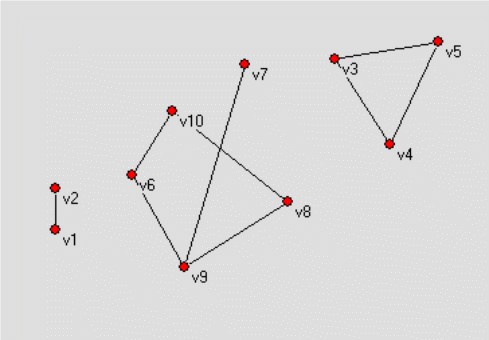
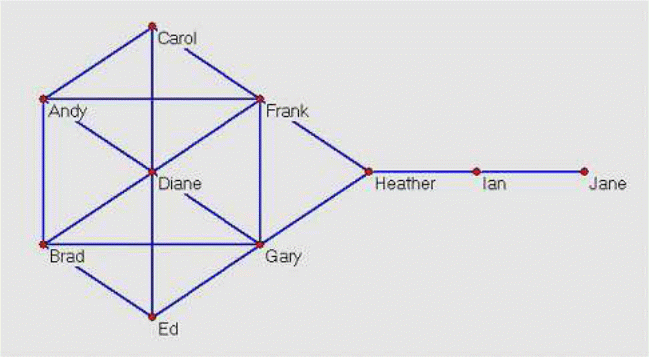
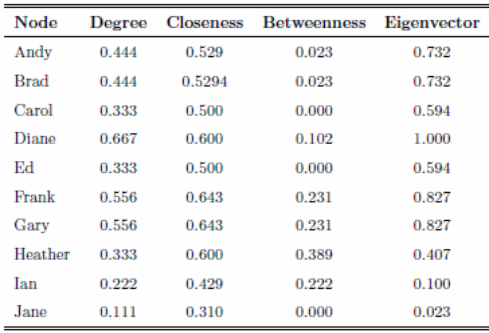
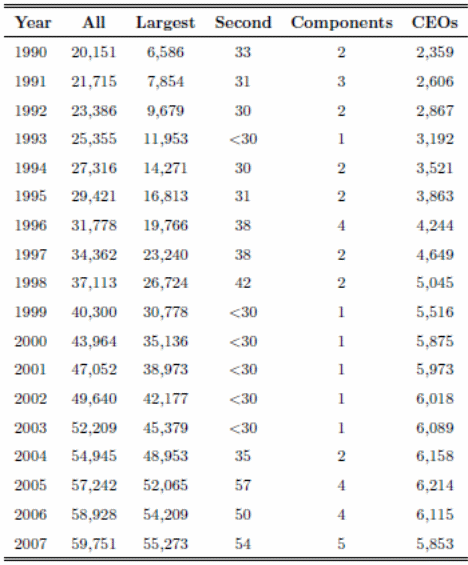
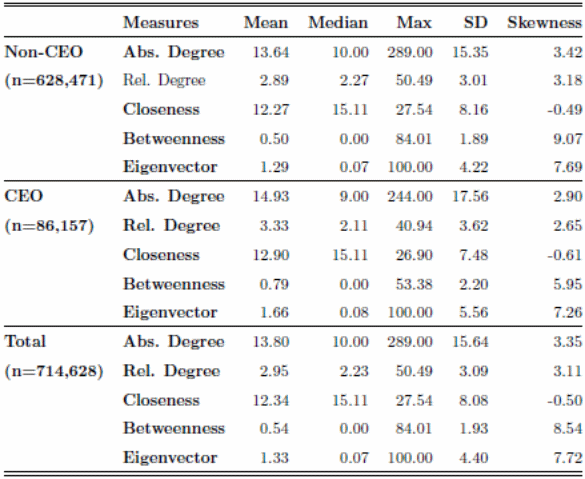
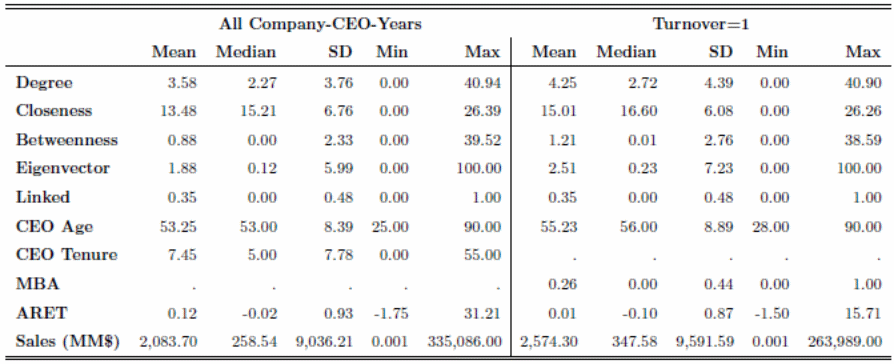
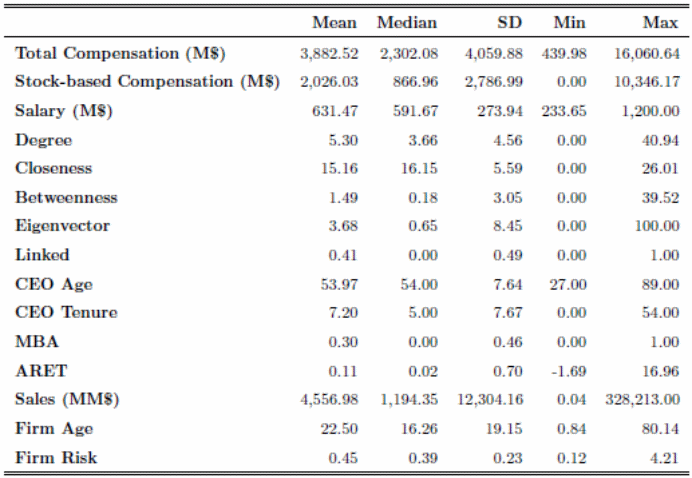
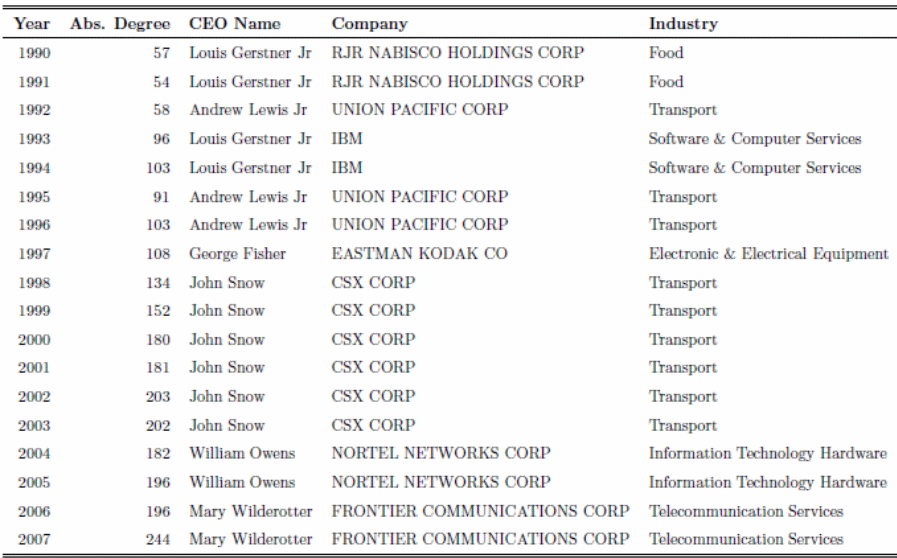
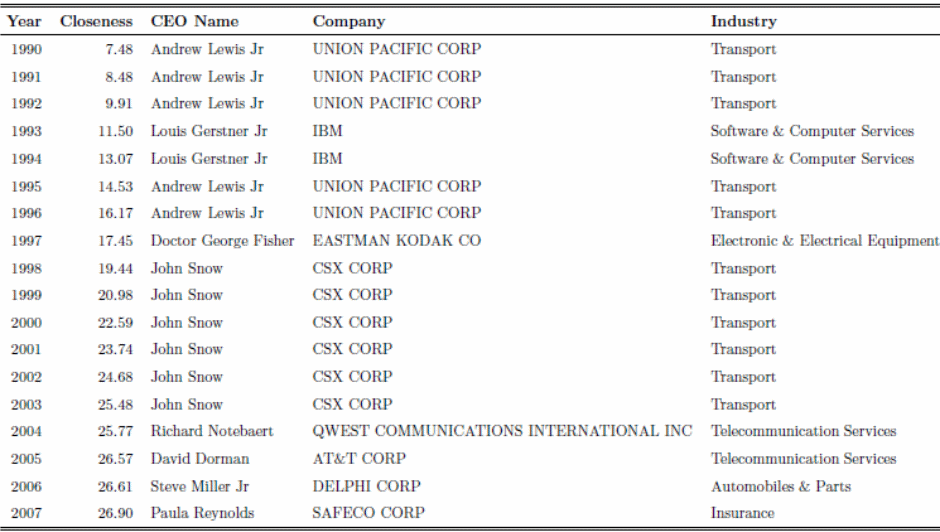
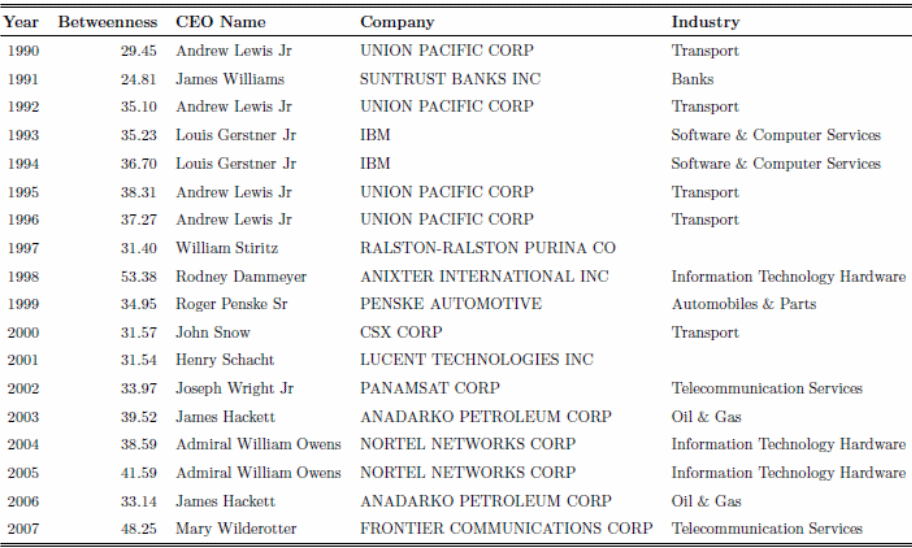
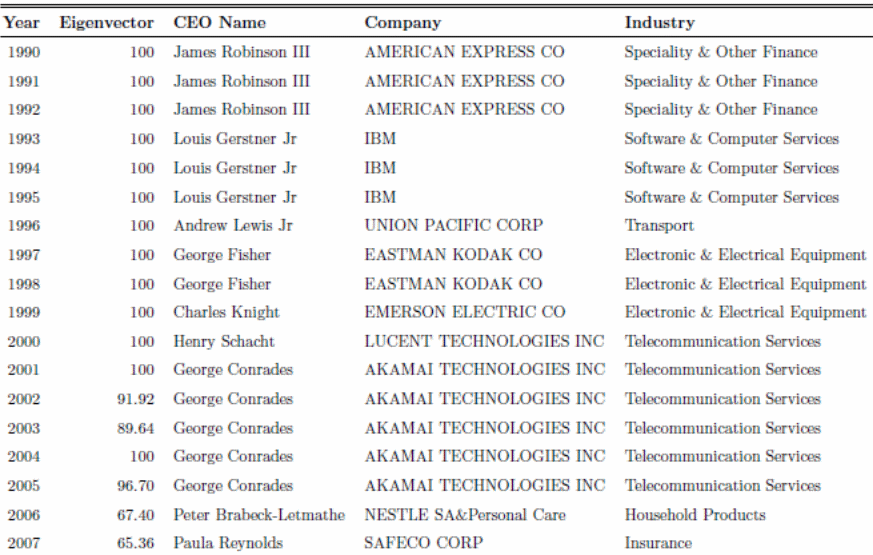
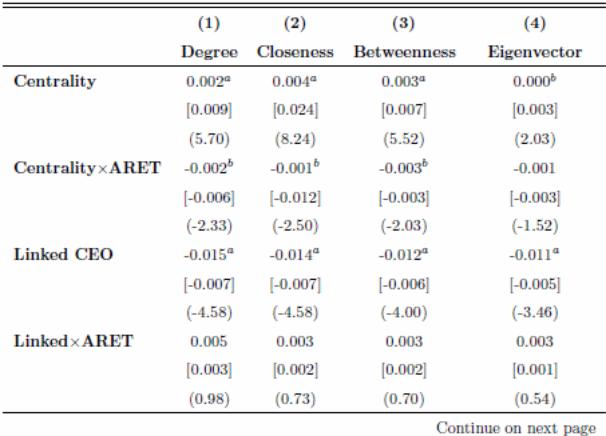
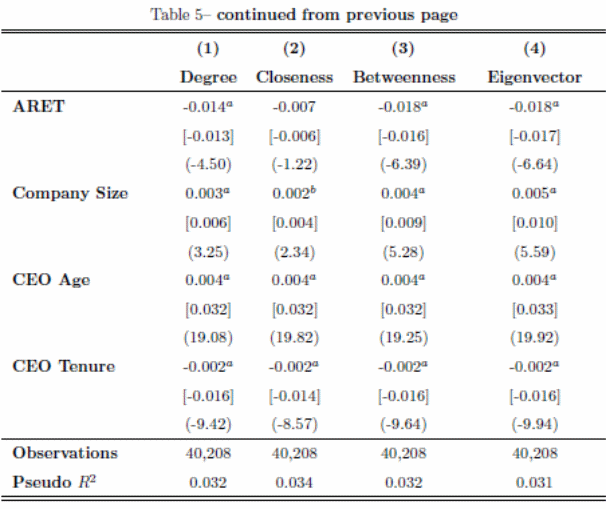
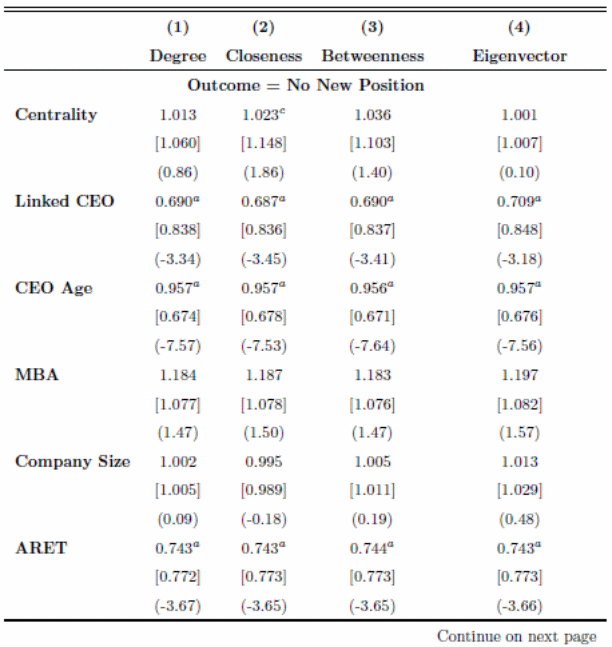
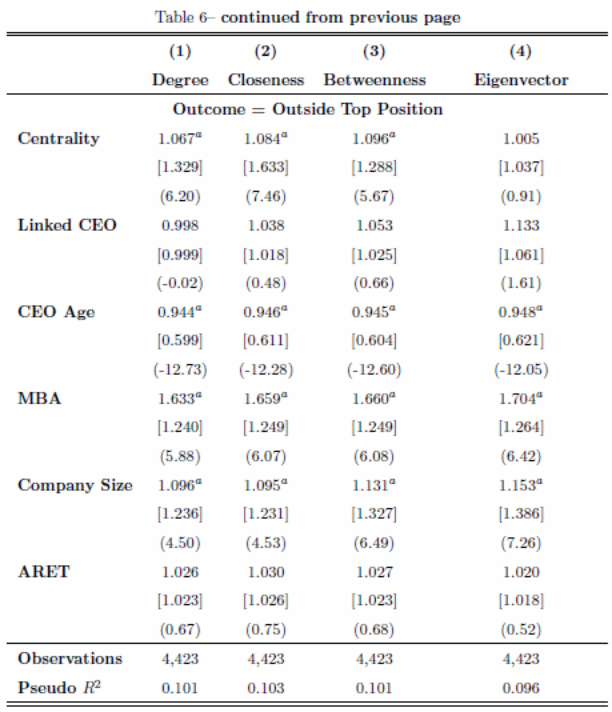
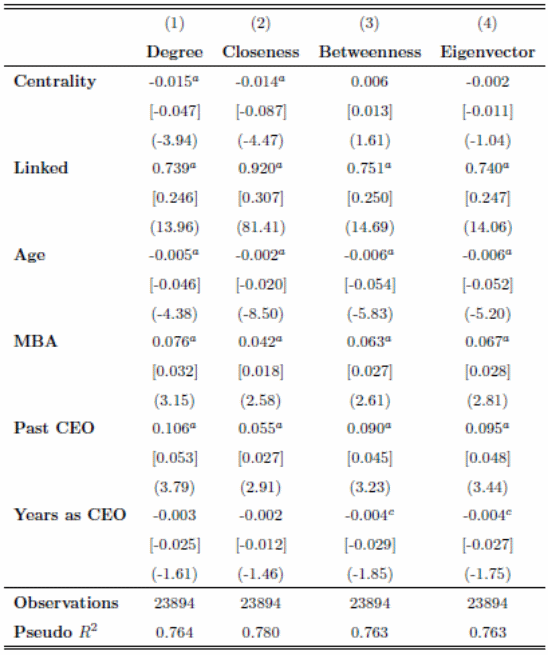
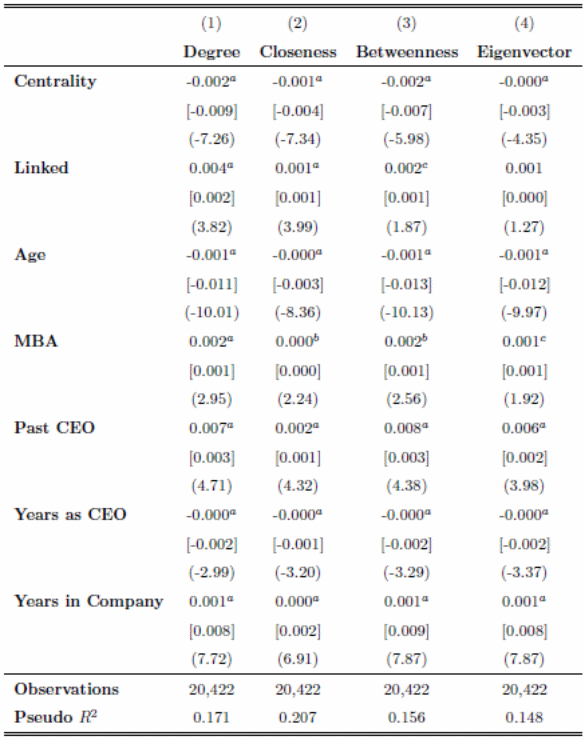
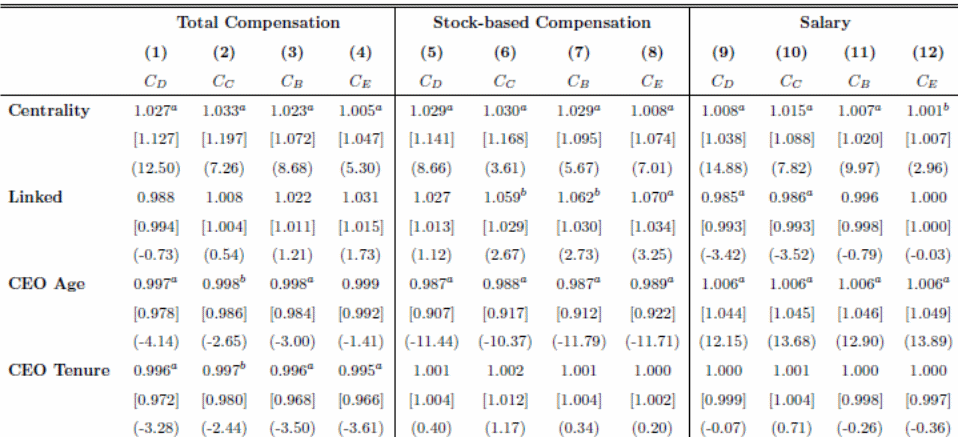
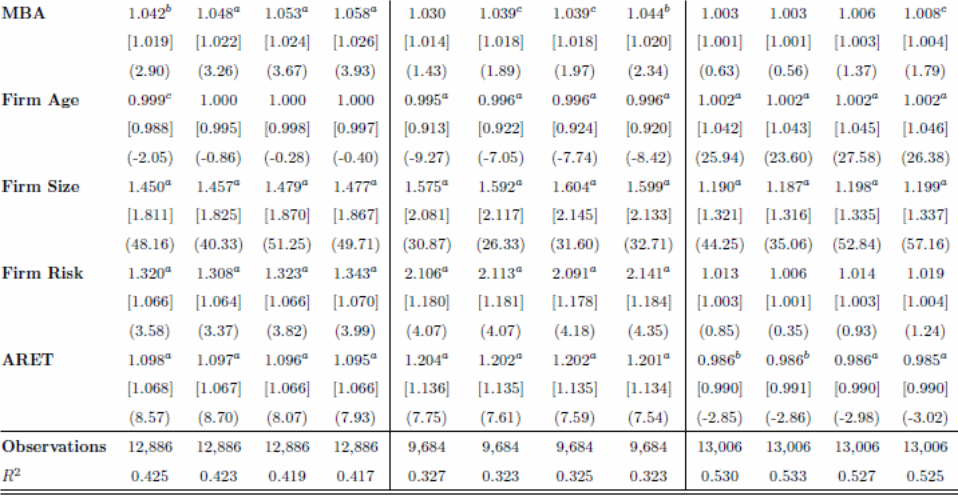
References
Adams, R & Ferreira, D 2007, ‘A Theory of Friendly Boards’, Journal of Finance, vol. 62, pp.217-250.
Adler, P & Kwon, S 2002, ‘Social capital: Prospects for a New Concept’, Academy of Management Review, vol.27, pp.17-40.
Allen, M 1974, ‘The Structure of Inter-organizational Elite Cooptation: Interlocking Corporate Directorates’, American Sociological Review, vol. 39, pp.393-406.
Ang, J, Nagel, G & Yang, J 2009, The effect of social pressures on CEO compensation, Indiana University working paper.
Baker, W & Iyer, D 1992, ‘Information Networks and Market Behavior’, Journal of Mathematical Sociology, vol. 16, pp.305-332.
Barcelo, D 2000, Sample Handling and Trace Analysis of Pollutants: Techniques and Applications, Elsevier, New York.
Barnea, A & Guedj, I 2007, CEO Compensation and Director Networks, University of Texas, Austin.
Barr, A 2000, ‘Social Capital and Technical Information Flows in the Ghanaian Manufacturing Sector’, Oxford Economic Papers, vol. 52, no.3, pp.539-559.
Batagelj V & Mrvar, A 2009, Pajek – Program for Large Network Analysis (Version 1.24).
Bebchuk, L & Fried, J 2004, Pay Without Performance: The Unfulfilled Promise of Executive Compensation, Harvard University Press, Cambridge, MA.
Bonacich, P1972, ‘Factoring and weighting approaches to status scores and clique identification’, Journal of Mathematical Sociology, vol. 2, pp. 113–120.
Boxman, E, De Grant, P & Flap, D 1991, ‘The Impact of Social and Human Capital on the Income Attainment of Dutch Managers’, Social Networks, vol.13, pp.51-73.
Boyd, B 1990, ‘Corporate Linkages and Organizational Environment: A Test of the Resource Dependence Model’, Strategic Management Journal, vol.11, pp.419-430.
Brown, R, Lee, E, Ning G & Stathopoulos, K 2008, What are Friends For? CEO Networks, Pay and Corporate Governance, Working paper, Manchester Business School, Manchester.
Bryman, A & Bell, E 2003, Business Research Methods, Oxford University Press, Oxford.
Burt, R 2000, Structural Holes versus Network Closure as Social Capital, New York, Russel Sage Foundation.
Burt, R 2001, The Social Capital of Structural Holes, Russel Sage Foundation, New York.
Burt, R 2005, Brokerage and Closure: An Introduction to Social Capital, Oxford University Press, Oxford.
Burt, R1987, ‘Social Contagion and Innovation: Cohesion versus Structural Equivalence’, American Journal of Sociology, vol.92, pp.1287-1335.
Burt, S 1992, Structural Holes: The Social Structure of Competition, Harvard University Press.
Carter, S 2009, The Social Validity Manual. A Guide to Subjective Evaluation of Behavior, Academia Press, New York.
Cofer, C & Appley, M 1967, Motivation: Theory and Research, John Wiley and Sons, New York.
Cohen, L, Frazzini, A & Malloy, C 2008, ‘The small world of investing: Board connections and mutual fund returns’, Journal of Political Economy, vol. 116, pp. 951–979.
Conyon, M & Murphy, K 2000, ‘The Prince and the Pauper: CEO Pay in the US and UK’, Economic Journal, vol.110, pp.640-671.
Conyon, M & Peck, S1998, ‘Board Control, Remuneration Committees and Management Compensation’, Academy of Management Journal, vol.41, pp.146-157.
Coopers, R 2005, Employment Law: Attendance Rewards-Legal Ramifications, John Wiley and Sons, Sidney.
Core, J & Guay, W 1999, ‘The Use of Equity Grants to Manage Optimal Equity Incentive Levels’, Journal of Accounting and Economics, vol.28, pp.151-184.
Core, J, Guay, D & Larcker, D 2008, ‘The Power of the Pen and Executive Compensation’, Journal of Financial Economics, vol.88, pp.1-25.
Core, J, Holthausen, R & Larcker, D 1999, ‘Corporate Governance, Chief Executive Officer Compensation, and Firm Performance’, Journal of Financial Economics, vol.51, pp.371- 406.
Creech, R 1995, ‘Employee Motivation’, Management Quarterly, Vol. 36, pp.33.
Cressy, R1996, ‘Are Business Startups Debt-rationed?’, The Economic Journal, vol.106, no.438, pp.253-270.
David, C 1958, Methods of Measuring Human Motivation, D. Van Nos-trand, Princeton.
David, C 1965, ‘Achievement Motivation Can Be Developed’, Harvard Business Review Vol. 43, pp. 68.
David, C 1965, ‘Achievement Motivation Can Be Developed’. Harvard Business Review, Vol. 43, pp. 68.
Davidsson, P & Honig, B 2003, ‘The Role of Social and Human Capital Among Nascent Entrepreneurs’, Journal of Business Venturing, Vol.18, No.3, pp.301-331.
Davis, G & Greve, H 1997, ‘Corporate Elite Networks and Governance changes in the 1980s’, American Journal of Sociology, Vol.103, pp.1-37.
De Nooy, W, Mrvar, A & Batagelj, V 2005, Exploratory Social Network Analysis with Pajek, Cambridge University Press, Cambridge.
De Wit, B & Meyer, R 2004, Strategy Process, Content, and Context International Perspective, Thomson Learning, New York.
Dean, J & Snell, S 1993, ‘Integrated Manufacturing and Job Design: The Moderating Effect of Organizational Inertia’, Harvard Business Review, Vol. 43, pp 79.
Deci, E & Ryan, R 1985, Intrinsic motivation and self-determination in human behavior, Plenum, New York.
Easterby, M, Thorp, R & Lowe, A 2008, Management Research, Sage Publications, New York.
Fama, E & Jensen, M 1983, ‘Separation of Ownership and Control’, Journal of Law and Economics, Vol.26, pp.301-25.
Fama, E1980, ‘Agency Problems and the Theory of the Firm’, Journal of Political Economy, Vol.88, pp.288-307.
Fernández, R, Castilla, E, & Moore, P 2000, ‘Social Capital at Work: Networks and Employment at a Phone Center’, American Journal of Sociology, Vol.105, No.5, pp.1288-1356.
Fich, M & Shivdasani, A 2006, ‘Are busy boards effective monitors?’, Journal of Finance, vol. 61, pp. 689–724.
Field, J 2003, Social Capital, London, Routledge.
Fracassi, C 2008, Corporate finance policies and social networks, UCLA working paper.
Freeman, L1977, ‘A set of measures of centrality based on between-ness’, Sociometry, vol. 40, pp. 35–41.
Freeman, L.C. (1979), ‘Centrality in Social Networks: Conceptual Clarification’, Social Networks, Vol.1, pp.215-239.
Freeman, L1980, ‘The Gatekeeper, Pair-dependency and Structural Centrality’, Quality and Quantity, Vol.14, pp.585-592.
Gabaix, X & Landier, A 2008, ‘Why has CEO Pay Increased So Much?’, Quarterly Journal of Economics, Vol.123, pp.49-100.
Granovetter, M 1973, ‘The Strength of Weak Ties’, American Journal of Sociology, Vol.78, pp.1360-1380.
Granovetter, S 1974, Getting a Job: A Study of Contacts and Careers, University of Chicago Press, Chicago.
Granovetter, S 1995, Getting a Job: A Study of Contacts and Careers, University of Chicago Press, Chicago.
Gui, B 2000, ‘Beyond Transactions: On the Interpersonal Dimensions of Economic Reality’, Annals of Public and Cooperative Economics, Vol.71, No.2, pp.139-169.
Hallock, K 1997, ‘Reciprocally Interlocking Boards of Directors and Executive Compensation’, Journal of Financial and Quantitative Analysis, Vol.32, pp.331-344.35.
Hambrick, D & Finkelstein, S 1995, ‘The Effects of Ownership Structure on Conditions at the Top: The case of CEO Pay Raises’, Strategic Management Journal, Vol.16, pp.175-193.
Haunschild, P & Beckman, C 1998, ‘When do Interlocks Matter? Alternative Sources of Information and Interlock Influence’, Administrative Science Quarterly, Vol.43, pp.815-844.
Hillman, A, Keim, G & Luce, R 2001, ‘Board Composition and Stakeholder Performance: Do Stakeholder Directors Make a Difference?’ Business and Society, Vol.40, pp.295-314.
Huson, R, Parrino, R, & Starks, L 2001, ‘Internal monitoring mechanisms and CEO turnover: A long-term perspective’, Journal of Finance, vol. 56, pp. 2265–2297.
Hwang, B & Kim, S 2009, ‘It pays to have friends’, Journal of Financial Economics, vol. 93, pp. 138–158.
Johnson, J, Daily, C & Ellstrand, A 1996, ‘Boards of Directors: A Review and Research Agenda’, Journal of Management, Vol.22, pp.409-438.
Kay, I & Van Putten, S 2007, Myths and Realities of Executive Pay, Cambridge University Press, Cambridge.
Kennish, J 1994, ‘Motivating with a Positive, Participatory Policy’. Security Management, Vol. 3, pp.12.
Khurana, R 2000, Three-party exchanges: The case of executive search firms and CEO search, Harvard Business School Working Paper.
Kinicki, R 2009, Organizational Behavior, McGraw-Hill Education, New York.
Kinni, T 1994, ‘The Empowered Workforce’. Industry Week, Vol. 2, pp. 6.
Klein, A 1998, ‘Firm Performance and Board Committee Structure’, Journal of Law and Economics, Vol.41, pp.275-299.
Krackhardt, D 1990, ‘Assessing the political landscape: Structure, cognition, and power in organizations’, Administrative Science Quarterly, pp. 342–369.
Kramarz, F & Thesmar, D 2006, Social networks in the board-room, IZA Discussion Paper No. 1940.
Lambert, R, Larcker, D & Weigelt, K 1993, ‘The Structure of Organizational Incentives’, Administrative Science Quarterly, Vol.38, pp.438-461.
Larcker, D, Richardson, S, Seary, A & Tuna, I 2005, Back Door Links between Directors and Executive Compensation, Working Paper, Stanford GSB.
Lin, N 2002, Social Capital: A Theory of Social Structure and Action, Cambridge University Press, Cambridge.
Lorsch, J & Maclver, E 1989, Pawns or Potentates: The Reality of America’s Corporate Boards, Harvard Business School Press, Cambridge, MA.
Main, B, O’Reilly, C & Wade, J 1995, ‘The CEO, the Board of Directors and Executive Compensation: Economic and Psychological Perspectives’, Industrial and Corporate Change, Vol.11, pp.292-332.
Meyerson, E1994, ‘Human Capital, Social Capital and Compensation: The Relative Contribution of Social Contacts to Managers’ Incomes’, Acta Sociologica, Vol.37, pp.383-399.
Mintzberg, H1983, Power in and Around Organization, Prentice-Hall, Englewood Cliffs, NJ.
Mizruchi, M & Stearns, L 1988, ‘A Longitudinal Study of the Formation of Interlocking Directorates’, Administrative Science Quarterly, Vol.33, pp.194-210.
Mizruchi, M 1996, ‘What do Interlocks do? An Analysis, Critique, and Assessment of Research on Interlocking Directorates’, Annual Review of Sociology, Vol.22, pp.271-298.
Moody, J & White, D 2003, ‘Social Cohesion and Embeddedness: A Hierarchical Conception of Social Groups’, American Sociological Review, Vol.68, pp.1-25.
Murphy, K 1999, Executive Compensation, Elsevier Science, New York and Oxford.
Newman, M 2003, ‘The structure and function of complex networks’, SIAM Review, vol. 45, pp. 167–256.
Palmer, D 1983, ‘Broken Ties: Interlocking Directorates and Intercorporate Coordination’, Administrative Science Quarterly, Vol.28, pp.40–55.
Parrino, R 1997, ‘CEO turnover and outside succession: A cross-sectional analysis’, Journal of Financial Economics, vol. 46, pp. 165–197.
Pfeffer, J & Salancik, G 1978, The External Control of Organizations: A Resource-Dependence Perspective, Harper & Row, New York.
Pfeffer, J 1972, ‘Size and Composition of Corporate Boards of Directors: The Organization and its Environment’, Administrative Science Quarterly, Vol.17, pp.218-228.
Powell, W & Smith-Doerr, L 1997, Networks and Economic Life, Princeton University Press, Princeton.
Proctor, C & Loomis, P 1951, Analysis of sociometric data, Dryden Press, New York.
Raheja, C 2005, ‘Determinants of Board Size and Composition: A Theory of Corporate Boards’, Journal of Financial and Quantitative Analysis, Vol.40, pp.283-306.
Rosen, S 1992, Contracts and the Market for Executives, Blackwell, Cambridge MA and Oxford.
Sabidussi, G 1966, ‘The centrality index of a graph’, Psychometrika vol. 31, pp. 581-603.
Saunders, M, Lewis, P & Thornhill, R 2009, Research Methods for Business Students, Prentice Hall, New York.
Seidman, S1983, ‘Network Structure and Minimum Degree’, Social Networks, Vol.5, pp.269-287.
Smith, C & Watts, R1992, ‘The Investment Opportunity Set and Corporate Financing, Dividend and Compensation Policies’, Journal of Financial Economics, Vol.32, pp.263-292.
Stephenson, K & Zelen, M 1989, ‘Rethinking Centrality: Methods and Examples’, Social Networks, Vol.11, pp.1-37.
Stokman, F, Ziegler, R & Scott, J 1985, Networks of Corporate Power, Polity Press, Cambridge.
Stuart, T & Yim, S 2008, Board interlocks and the propensity to be targeted in private equity transactions, NBER working paper.
Useem, M1984, The Inner Circle: Large Corporations and the Rise of Business Political Activity, Oxford University Press, New York.
Uzzi, B1997, ‘Social Structure and Competition in Interfirm Networks: The Paradox of Embeddedness’, Administrative Science Quarterly, Vol.42, pp.35-67.
Wade, J, O’Reilly, A & Chandratat, I 1990, ‘Golden Parachutes: CEOs and the Exercise of Social Influence’, Administrative Science Quarterly, Vol.35, pp.587-603.38.
Wasserman, S & Faust, K 1997, Social Network Analysis: Methods and Applications, Cambridge University Press, New York.
Westphal J1999, ‘Collaboration in the Boardroom: Behavioral and Performance Consequences of CEO-board Social Ties’, The Academy of Management Journal, Vol.42, pp.7-24.
Williamson, O 1984, ‘Corporate Governance’, Yale Law Journal, Vol.3, pp.1197-1229.
Wooldridge, J 2001, Econometric Analysis of Cross-section and Panel Data, MIT Press.
Yermack, D 1996, ‘Higher Market Valuation of Companies with a Small Board of Directors’, Journal of Financial Economics, Vol.40, pp.185-212.
Zahra, S & Pearce, J 1989, ‘Boards of Directors and Corporate Financial Performance: A Review and Integrative Model’, Journal of Management, Vol.15, pp.291-244.